Physical Address
304 North Cardinal St.
Dorchester Center, MA 02124
This chapter covers the different diseases in which there is injury to the intrahepatic and/or extrahepatic bile ducts ( Box 9.1 ). The disorders are varied; some, although selectively affecting the bile ducts, are discussed in more detail elsewhere in this volume, and appropriate chapter cross-references are given. In this chapter we emphasize the histological features that characterize the early stages of the disease in which distinctive bile duct lesions may be identified in liver biopsies. In some of these conditions, especially primary biliary cholangitis (PBC), chronic liver allograft rejection and graft-versus-host disease (GVHD), the interlobular bile ducts up to a diameter of 100 µm are selectively damaged and progressively disappear from the liver, the so-called vanishing bile duct or ductopenic disorders. In other diseases, these structures may be affected together with larger intrahepatic and extrahepatic bile ducts, especially in both primary sclerosing cholangitis (PSC) and secondary sclerosing cholangitis (SSC). Progressive destruction and loss of the intrahepatic bile ducts typically result in other changes that lead to portal–portal bridging fibrosis and eventually biliary cirrhosis. Thus in their later stages, the various diseases share many pathological features, which in turn closely resemble the changes observed with secondary biliary cirrhosis.
Ductal plate malformation (infantile polycystic disease, congenital hepatic fibrosis, Caroli disease) ( Chapter 3 )
Biliary atresia ( Chapter 3 )
Paucity of interlobular bile ducts (syndromic and nonsyndromic) ( Chapter 3 )
α1-Antitrypsin deficiency ( Chapter 3 )
Cystic fibrosis ( Chapter 3 )
Primary sclerosing cholangitis with or without ulcerative colitis
With autoimmune features (‘autoimmune sclerosing cholangitis’)
Perinatal onset
Secondary sclerosing cholangitis (immunodeficiency, Langerhans cell histiocytosis)
Primary biliary cholangitis
Primary sclerosing cholangitis with or without ulcerative colitis
Overlap syndromes: PBC/PSC + autoimmune hepatitis
IgG4-related sclerosing cholangitis
Follicular cholangitis
Eosinophilic cholangitis
Secondary sclerosing cholangitis
Opportunistic (primary or secondary immunodeficiency: AIDS)
Ischaemic (arterial cytotoxic infusion, liver allograft) ( Chapter 14 )
Toxic (treated hydatid cyst)
Idiopathic adulthood ductopenia
Hepatic allograft rejection ( Chapter 14 )
Graft-versus-host disease ( Chapter 14 )
Suppurative cholangitis, usually with biliary obstruction
Sarcoidosis ( Chapter 15 )
Hodgkin lymphoma ( Chapters 13 and 15 )
Drug reactions ( Chapter 12 )
Immune-mediated adverse effect of immune checkpoint inhibitor ( Chapter 12 )
Extrahepatic obstruction
Viral hepatitis, especially HCV, cytomegalovirus ( Chapters 6 and 7 )
Septicaemia, endotoxic shock and toxic shock syndrome
Parasitic infestation ( Chapter 7 )
Recurrent pyogenic cholangitis/hepatolithiasis
The term ‘cholangiopathy’ is collectively applied to the diseases in which cholangiocytes are the primary target of the disease process. In contrast to extrahepatic biliary obstruction, chronic intrahepatic bile duct lesions may evolve over many years without obvious morphological cholestasis or bilirubinostasis. This period of evolution is characterized by characteristic changes at the interface between portal tracts and parenchyma: cholate stasis or biliary interface activity , previously known as ‘biliary piecemeal necrosis’. We review these features in depth because in the absence of characteristic bile duct lesions, their recognition is essential to distinguish biliary from other forms of chronic liver disease. The role of liver biopsies in patients with PBC or PSC has changed over the last decade, as discussed in relevant sections. Biliary disorders selectively affect different segments of the biliary tree, so the first section outlines the anatomical features relevant to the classification and nomenclature of the biliary disorders (see Chapter 1 ). We then review basic pathogenetic mechanisms common to many of the distinct entities discussed later in the chapter.
The right and left hepatic ducts, their confluence and both the common hepatic duct and the common bile duct are classified as the extrahepatic bile ducts, while the bile ducts proximal to the right or left hepatic duct are referred to as intrahepatic bile ducts. The bile ducts are lined by cholangiocytes, which play a number of roles, in particular contributing to about 30–40% of total bile secretion, participating in bile acid reabsorption and drug metabolism and mediating immune responses. , They constitute approximately 4–5% of the liver mass. The intrahepatic branching of the bile ducts is best visualized on a biliary injection cast ( Fig. 9.1 ). There is no sharp delineation of the various segments, but the intrahepatic bile ducts can be practically classified into two main categories:
Large intrahepatic bile ducts. These consist of first to third branches the right and left hepatic bile ducts (segmental and area bile ducts), all of which are grossly visible. , They are lined by tall columnar epithelium and are surrounded by a layer of hypocellular collagen (duct wall).
Small intrahepatic bile ducts. These are the branches of the large intrahepatic bile duct and are classified into the ‘septal’ and ‘interlobular’ bile ducts, which are visible only under the microscope, the former being inconsistently sampled in needle biopsy specimens.

As with the large intrahepatic ducts, the septal ducts (>100 µm in diameter) are lined by tall columnar cells with basal nuclei and are surrounded by a fibrous duct wall. In contrast, the interlobular bile ducts are lined by cuboidal cells resting on a basement membrane. The interlobular bile ducts are connected to the bile canalicular network by bile ductules (<20 µm diameter) lined by cuboidal cells and the canals of Hering, which are lined partly by biliary epithelium and partly by hepatocytes. Bile ductules and canals of Hering become obvious in various pathological conditions and are more easily identifiable by immunostaining for biliary keratins. ,
Peribiliary glands are present within the fibromuscular walls of extrahepatic bile ducts ( Fig. 9.2A, B ) and also along the large intrahepatic bile ducts. , Glandular acini along the large intrahepatic bile duct arise from ductal plates, and their density decreases progressively through infancy and childhood. Similar glandular elements are also found at the neck of gallbladder and the ampulla of Vater. Peribiliary glands around the large intrahepatic bile ducts are subdivided into intramural, nonbranching tubular glands and extramural ramified glands. The latter lie in the periductal connective tissue and have a linear distribution along two opposite sides of the bile ducts in a three-dimensional (3D) model ( Fig. 9.2C ); they indirectly drain into the bile duct lumen via their own conduit ( Fig. 9.3A ). The extramural glands show anastomosing bridges and consist of serous and mucous acini ( Fig. 9.3B, C ). Pancreatic acini without Langerhans islets are found intermingled with peribiliary glandular acini in about 4% of autopsy livers and are probably an intrinsic component or metaplasia of these glands ( Fig. 9.3D ), most likely reflecting a common embryological origin. , In addition to their absorptive and secretory activities, the peribiliary glands contain multipotent stem/progenitor cells that can differentiate into hepatocytes, cholangiocytes and pancreatic acinar cells. , These cells supposedly contribute to epithelial regeneration, and the defects of the repair process may be involved in the progression of biliary diseases, including the development of periductal fibrosis, bile duct dysplasia and cholangiocarcinoma in PSC.
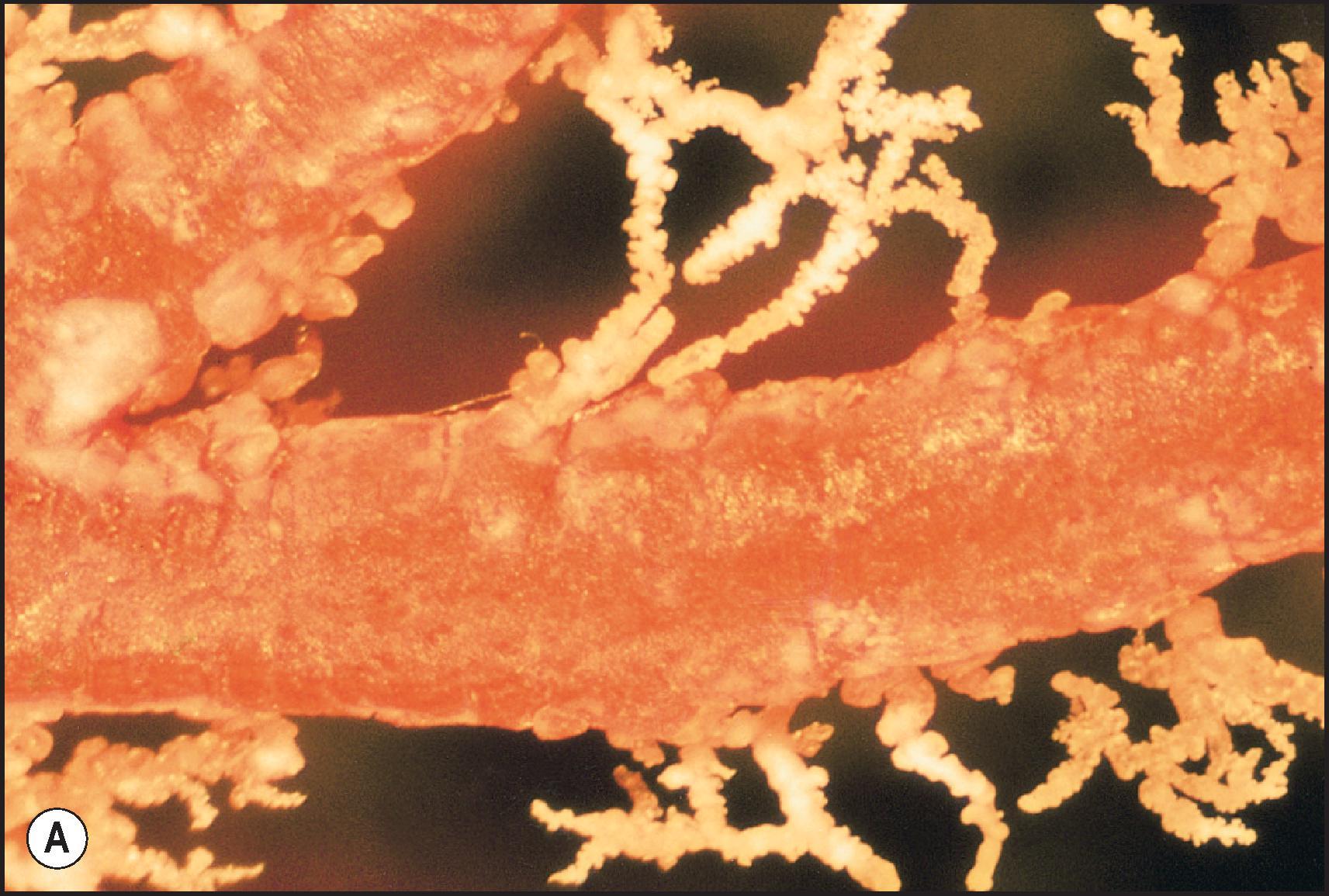
![Figure 9.3, Peribiliary glands. (A) The glands (large arrow) are arranged as lobules and drain into the intrahepatic large bile duct via their own conduit (small arrow) , the latter being filled with contrast medium. (B, C) At higher magnification, extramural glands are arranged as lobules surrounded by fibrous tissue. The lobules (arrows) consist of mucinous (B) and serous (C) acini, which are usually mixed in individual lobules. (D) Admixed with extramural peribiliary glands are pancreatic exocrine acini (arrows). (Haematoxylin and eosin [H&E] stain.) Figure 9.3, Peribiliary glands. (A) The glands (large arrow) are arranged as lobules and drain into the intrahepatic large bile duct via their own conduit (small arrow) , the latter being filled with contrast medium. (B, C) At higher magnification, extramural glands are arranged as lobules surrounded by fibrous tissue. The lobules (arrows) consist of mucinous (B) and serous (C) acini, which are usually mixed in individual lobules. (D) Admixed with extramural peribiliary glands are pancreatic exocrine acini (arrows). (Haematoxylin and eosin [H&E] stain.)](https://storage.googleapis.com/dl.dentistrykey.com/clinical/BileDuctDiseases/2_3s20B9780702082283000090.jpg)
The bile duct shares embryological and histological features with the pancreas, since the two organs develop from the endoderm foregut and have nearly identical ductal epithelium, with analogous morphology and immunohistochemical phenotypes. Similar neoplastic and non-neoplastic diseases can also occur in the two organ systems ( Box 9.2 ).
IgG4-related sclerosing cholangitis and type 1 autoimmune pancreatitis
Peribiliary cysts and chronic pancreatitis in alcoholic patients
Cystic fibrosis affecting bile ducts and pancreas
Follicular cholangitis and pancreatitis
Mucinous cystic neoplasms
Intraductal papillary/mucinous neoplasms
Intraductal tubulopapillary neoplasms
Perihilar cholangiocarcinoma and pancreatic ductal carcinoma
Biliary and pancreatic intraepithelial neoplasia (BilIN and PanIN)
Biliary epithelium may undergo a range of histopathological changes that often lack specificity and differ according to the size of the affected ducts. In the extrahepatic and large intrahepatic bile ducts, biliary epithelial swelling and atrophy, disordered nuclear polarity and sloughing are encountered in both inflammatory and neoplastic conditions. This may lead to ulceration with a granulomatous or xanthomatous reaction induced by extravasated bile products. In the interlobular bile ducts, cytoplasmic vacuolation, eosinophilic change, nuclear pleomorphism and hyperchromasia are common degenerative changes. Nuclear ‘piling up’ suggests regeneration, which may be substantiated by immunostaining for proliferative markers, although mitoses are rarely seen. Proliferation of biliary epithelium is associated with subsequent luminal enlargement. Nuclear pyknosis, apoptosis, fading and uneven spacing anticipate duct loss. Injured ducts can be variably distorted with an irregularly shaped lumen. Rupture of the duct basement membrane is followed by dilation which, as in the case of early PBC, may lead to an overestimation of the actual size of the affected duct; small diverticula may rarely form. Bile duct damage can be classified into several categories, as summarized in the following sections. More characteristic histopathological alterations are considered and illustrated later in relation to individual disorders.
Necrosis and apoptosis are classical types of cell death caused by cellular stresses or injuries, and they differ in mechanism, microscopic appearance and roles in biliary diseases. Necrosis of cholangiocytes is always pathological.
The role of apoptosis in bile duct injury may be underestimated because apoptotic cells are rapidly eliminated from the biliary tree and are probably shed into bile. Apoptosis is difficult to identify and quantify in haematoxylin and eosin (H&E)-stained sections, but shrunken slender cells with pyknotic nuclei and fragmented and condensed nuclei in the biliary epithelial layer and bile duct lumen are regarded as apoptotic bodies ( Fig. 9.4A ). This can be confirmed using in situ nick-end labelling and immunostaining of single-strand DNA, both of which detect DNA fragmentation ( Fig. 9.4B ). Ultrastructurally, there is a reduction of cell volume with aggregated cytoplasmic organelles.
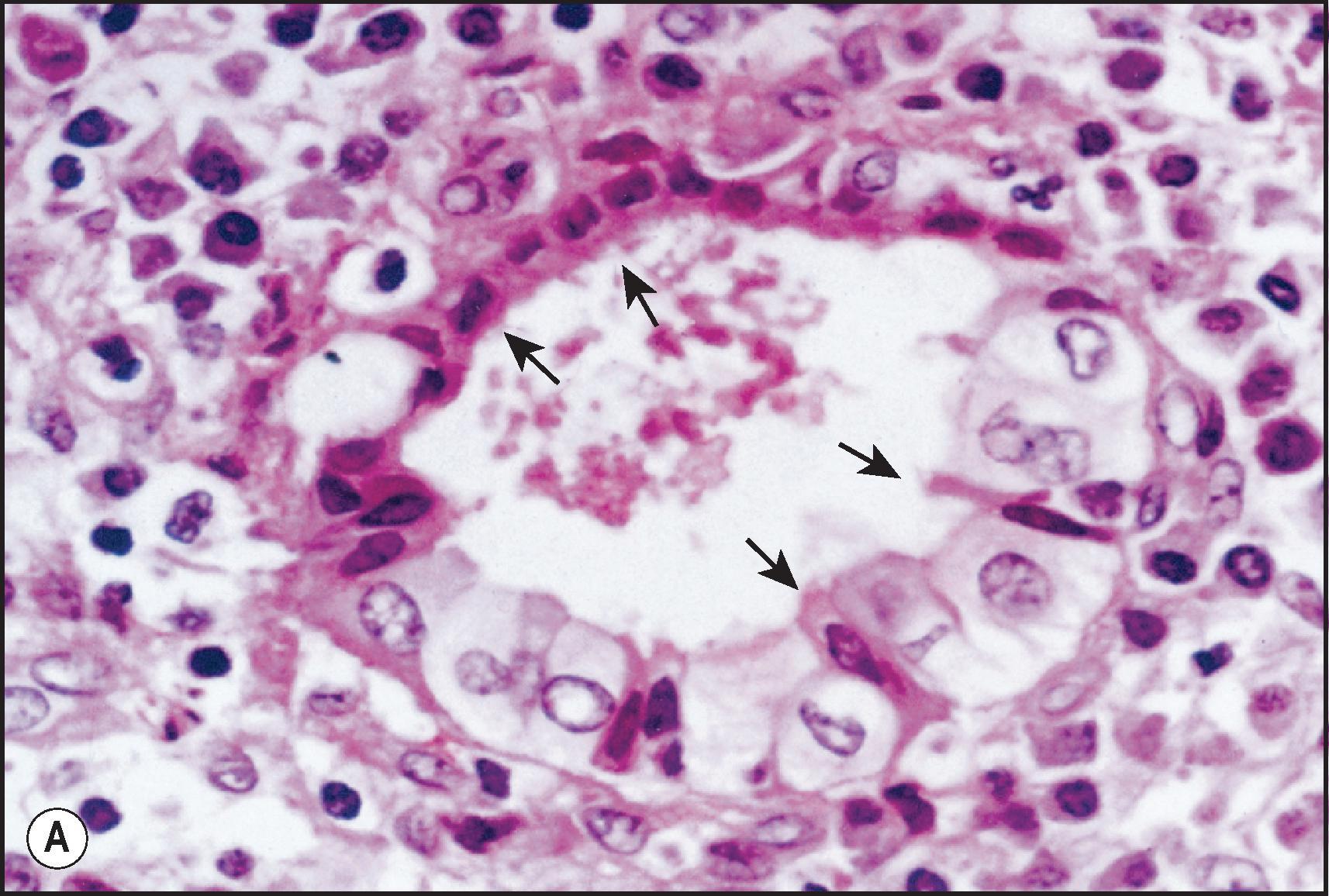
Apoptosis of cholangiocytes has been considered as an important pathogenetic process in several cholangiopathies. , Excessive apoptotic activity beyond the proliferative response of bile duct cells will result in ductopenia. In contrast, inhibition of the apoptotic process may cause hyperplasia of bile duct epithelium, with an increased risk of neoplastic transformation. In addition, the induction of apoptosis in cholangiocytes by leukocytes is itself important for the clearance of pathogens from the bile ducts.
Other forms of cell death such as necroptosis, parthanatos and pyroptosis have also been recognized. Their contributions to physiology and pathology of the bile duct remain to be clarified.
Cellular senescence is defined as a permanent growth arrest caused by several cellular injuries. It is a condition in which the cell no longer has the ability to proliferate, and senescent cells are irreversibly arrested at the G1 phase of the cell cycle. As with cholangiocytes activated by stresses or stimuli such as microbial products, they became senescent by dysregulated autophagy ( Fig. 9.5 ). Senescent cells are also known to remain metabolically active and then contribute to a persistent inflammation. Senescent cholangiocytes participate in biliary proinflammatory responses in various conditions because they are known to aberrantly express chemokines, cytokines, growth factors and matrix metalloproteinases (MMPs), leading to alterations of peribiliary microenvironments ( Fig. 9.6 ). This process is called a senescence-associated secretory phenotype. Cytokines and chemokines produced by senescent biliary epithelium may also facilitate cellular senescence in adjacent cholangiocytes and other types of cells in the periductal tissue. These processes are presumably involved in both tissue repair and disease progression of the biliary tract.

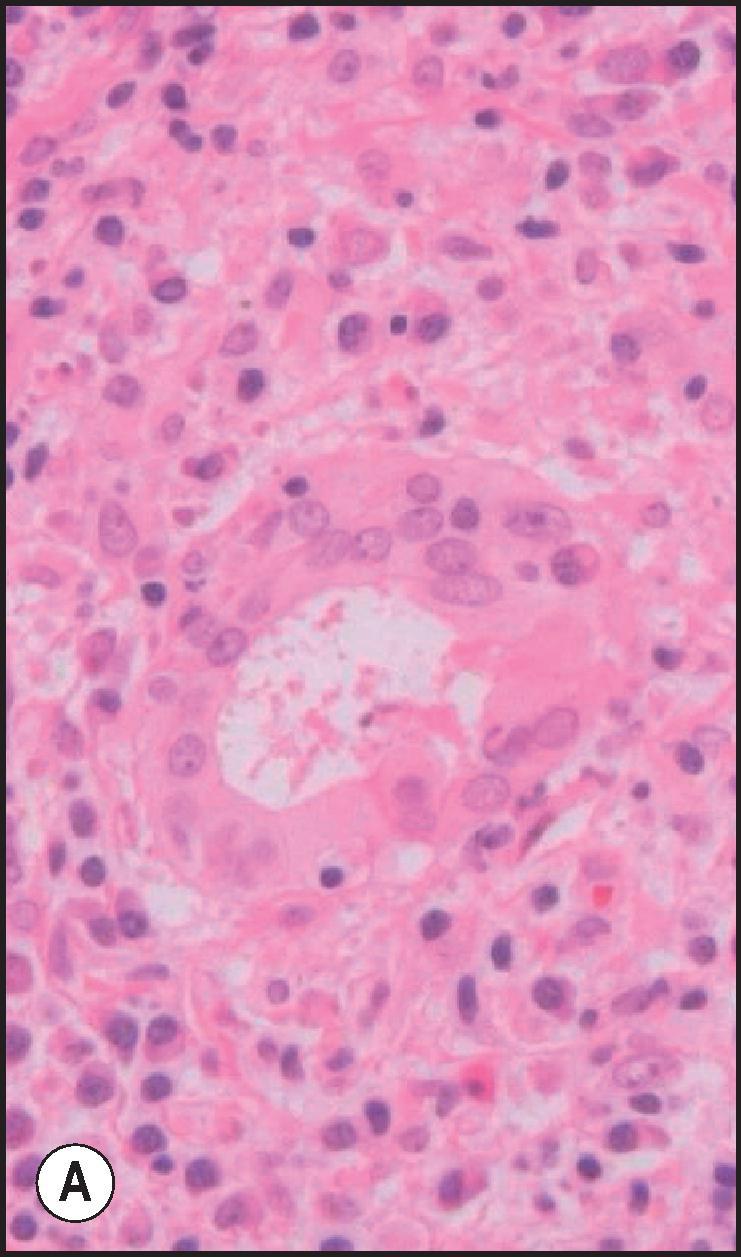
Damaged cholangiocytes in PBC and also chronic allograft rejection frequently show characteristic features such as eosinophilic cytoplasm, cellular and nuclear enlargement, nuclear pleomorphism, multinucleation and irregular arrangement with uneven nuclear spacing ( Fig. 9.6A ). The affected bile ducts may consequently acquire an atrophic or ‘dysplastic-like’ appearance. These changes are used for the diagnosis of early chronic rejection and may represent ongoing cellular senescence. In support of this, cells with these appearances present cellular senescence markers such as cell cycle regulator genes, p16 INK4 and p21 WAF1/CIP , and increased activity of senescence-associated β-galactosidase (SA-β-gal) ( Fig. 9.6B ). , Cellular senescence has also been observed in damaged bile ducts in PSC and biliary atresia. , The findings that the expression of senescence-related p21 WAF1/CIP protein is increased in the bile ducts during early chronic rejection and decreased with successful recovery suggest that in chronic liver allograft rejection and PBC, cellular senescence of cholangiocytes is responsible for impaired regeneration of bile ducts. , A relatively insufficient proliferative response caused by cellular senescence is also responsible for the progressive loss of bile ducts from apoptosis. , Quantitative fluorescence and in situ hybridization showed a significant decrease in telomere length in cholangiocytes of the damaged small bile ducts in PBC, compared with normal-looking bile ducts in PBC, chronic viral hepatitis and normal livers. Telomere shortening could be a trigger of cellular senescence.
Autophagy is an intracytoplasmic process of self-degradation to remove damaged proteins, organelles and external pathogens (e.g. bacteria) that are engulfed. This process occurs inside lysosomes and contributes to cellular homeostasis. Autophagy is activated during cellular senescence, in which it inhibits apoptotic signals. This process also appears to be involved with autoimmunity by presenting degraded intracytoplasmic ‘self’ antigens with major histocompatibility complex (MHC) class II molecules. In the bile duct, molecules involved in autophagy (e.g. microtubule-associated protein-light chain 3b [LC3], p62/sequestosome-1) are expressed in cholangiocytes, particularly in PBC and in biliary intraepithelial neoplasia (BilIN). , Although autophagy may play a role in the development or progression of biliary diseases, further studies are required to conclude whether activated autophagy of cholangiocytes is a primary event or simply secondary to increased cellular stress in damaged bile ducts. Although cellular senescence, autophagy and apoptosis are distinct cellular responses, they are associated with each other, sharing several intracellular signalling pathways ( Fig. 9.5 ).
Homeostasis of the biliary epithelium operates through a balance between apoptotic cell death or senescence and cell renewal. This is mainly regulated by the Bcl-2 family of proteins. Bcl-2, which prolongs cell survival by counteracting apoptosis, is diffusely expressed by cells of the interlobular bile ducts and ductules, while bax , a promoter of apoptosis, is expressed throughout the biliary tree. Renewal of the lining epithelium of small bile ducts and ductules may be secured by progenitor or stem cells located in the canal of Hering, a process unlikely to operate in the septal and large intrahepatic bile ducts. In the septal and large bile ducts, damaged cholangiocytes are replaced by the adjacent biliary epithelium. When the damage is severe, the peribiliary glands, which are supposed to contain biliary progenitor cells, may participate in the renewal of the lining epithelium. ,
Hyperplasia of lining epithelia of the septal and large bile ducts manifests as micropapillary projections or as a stratification of the epithelium with or without dilation of the duct lumen. In choledochal cysts with pancreatobiliary malunion, the surface epithelium of the dilated ducts often shows high papillary hyperplasia. Peribiliary glands, intramural or extramural, also show hyperplasia and proliferation and participate in the secretion of neutral, carboxylated and sulphated mucins into the bile duct lumen. When prominent, in particular with Clonorchis sinensis infection or hepatolithiasis, the term ‘adenomatous hyperplasia’ or ‘chronic proliferative cholangitis’ has been used ( Fig. 9.7A ). , Hyperplasia of small interlobular bile ducts and ductules leads to an increased number of apparently tortuous structures within the portal tracts. Increased ductules are generally referred to as a ductular reaction rather than ductular hyperplasia or proliferation.
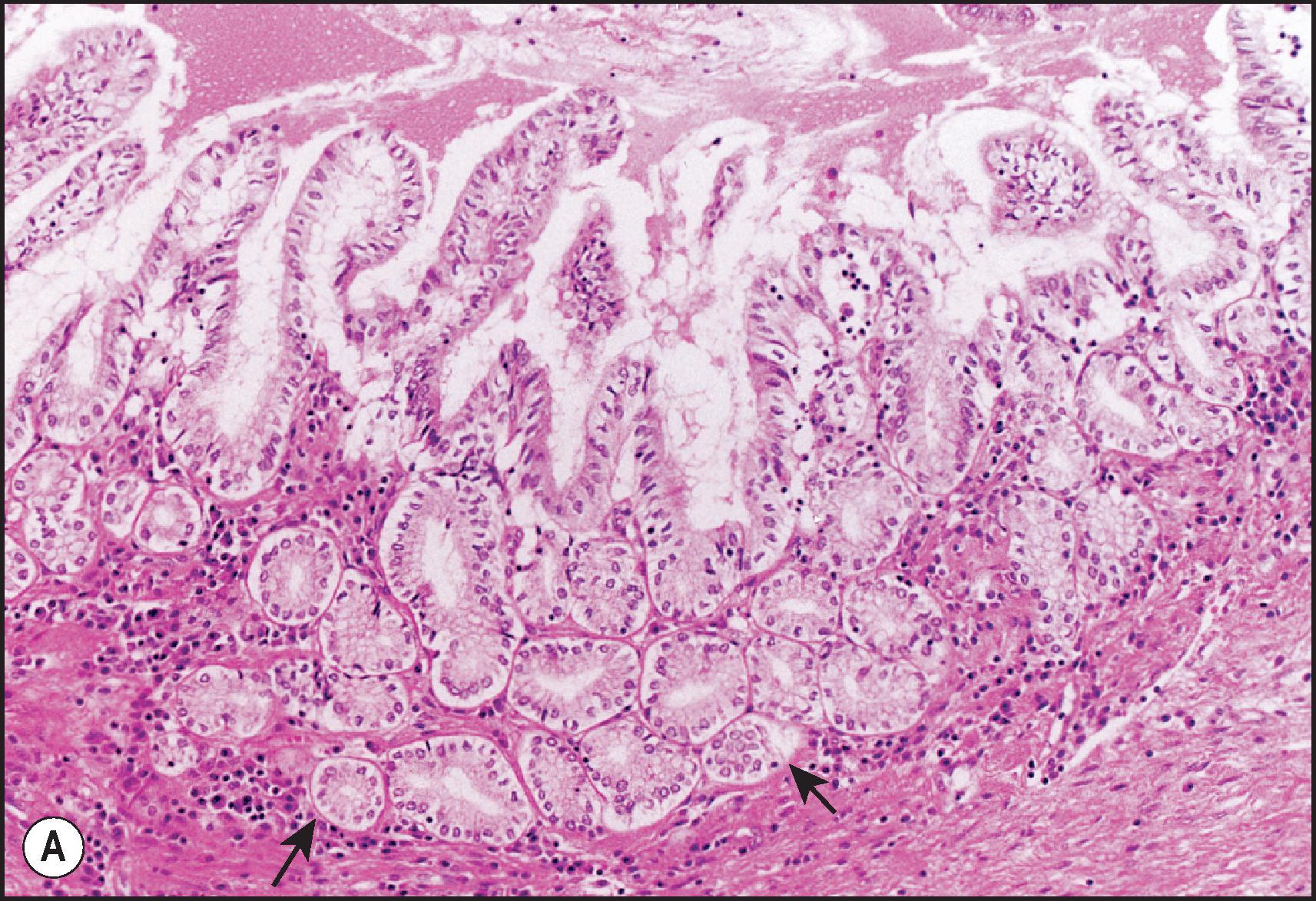
Mucin may become detectable histochemically in the supranuclear cytoplasm and on the luminal surface of interlobular bile ducts as a nonspecific response to various injuries. Metaplasia of biliary epithelium can be observed as follows. Gastrointestinal metaplasia (e.g. pyloric gland metaplasia or intestinal metaplasia) is seen in chronically inflamed large bile ducts and peribiliary glands ( Fig. 9.7A ). The change is associated with increased expressions of gastric-type mucin core protein (MUC) 5AC and MUC6 and intestinal-type MUC2. The aberrant expression of K20 and CDX2 is also associated with intestinal metaplasia. Morphologically goblet cells and Paneth cells may be encountered ( Fig. 9.7B ). Intestinal-type epithelium with goblet cells is physiologically present in otherwise normal gallbladders of children, particularly those younger than 6 years. Thus intestinal metaplasia in the bile ducts may represent a reacquisition of the immature phenotype rather than a real metaplastic process. The expression of other molecules in the lining of large intrahepatic bile ducts, such as REG I and trefoil factors, appears related to intestinal or gastric metaplasia. , Gastrointestinal phenotypes are also commonly seen in biliary neoplasms, including cholangiocarcinomas, BilIN and intraductal papillary neoplasm of the bile duct (IPNB). Hepatocytic metaplasia occurs in interlobular bile ducts and bile ductules in various pathological situations but remains of uncertain significance ( Fig. 9.7C ). The cells have a clear or weakly eosinophilic, glycogen-rich cytoplasm with a distinct border and rest on a basement membrane alongside normal biliary epithelium. They are morphologically almost identical to hepatocytes, although some may express a mixed hepatocytic and biliary phenotype. Squamous metaplasia is rarely encountered in longstanding inflammation of large bile ducts or in the lining of biliary cysts ( Fig. 9.7D ). Pancreatic acinar cells are infrequently seen in peribiliary glands, and whether they represent an intrinsic component or metaplasia of the glandular epithelium remains unclear ( Fig. 9.3D ).
BilIN representing a multistep neoplastic transformation of cholangiocytes is characterized by atypical, enlarged and hyperchromatic nuclei, an increased nuclear/cytoplasmic ratio and a loss of polarity. It is either micropapillary or flat, with a portion of the duct circumference replaced by a single-layer or multilayered dysplastic epithelium. Although a three-tier grading scheme was originally used, BilIN is currently classified into low and high grades. Low-grade BilIN (previous terms: BilIN-1, -2) demonstrates a mild to moderate increase in nuclear size, hyperchromasia and focal disturbance of cellular polarity ( Fig. 9.8A, B ). High-grade BilIN (BilIN-3) shows more obvious cellular atypia, including irregular nuclear membrane or marked disturbance of cellular polarity ( Fig. 9.8C ), and has also been referred to as carcinoma in situ . BilIN generally affects large intrahepatic or extrahepatic ducts or gallbladder, particularly those with chronic inflammation (e.g. PSC, hepatolithiasis, choledochal cyst), whilst these dysplastic changes are less common in septal and interlobular bile ducts.
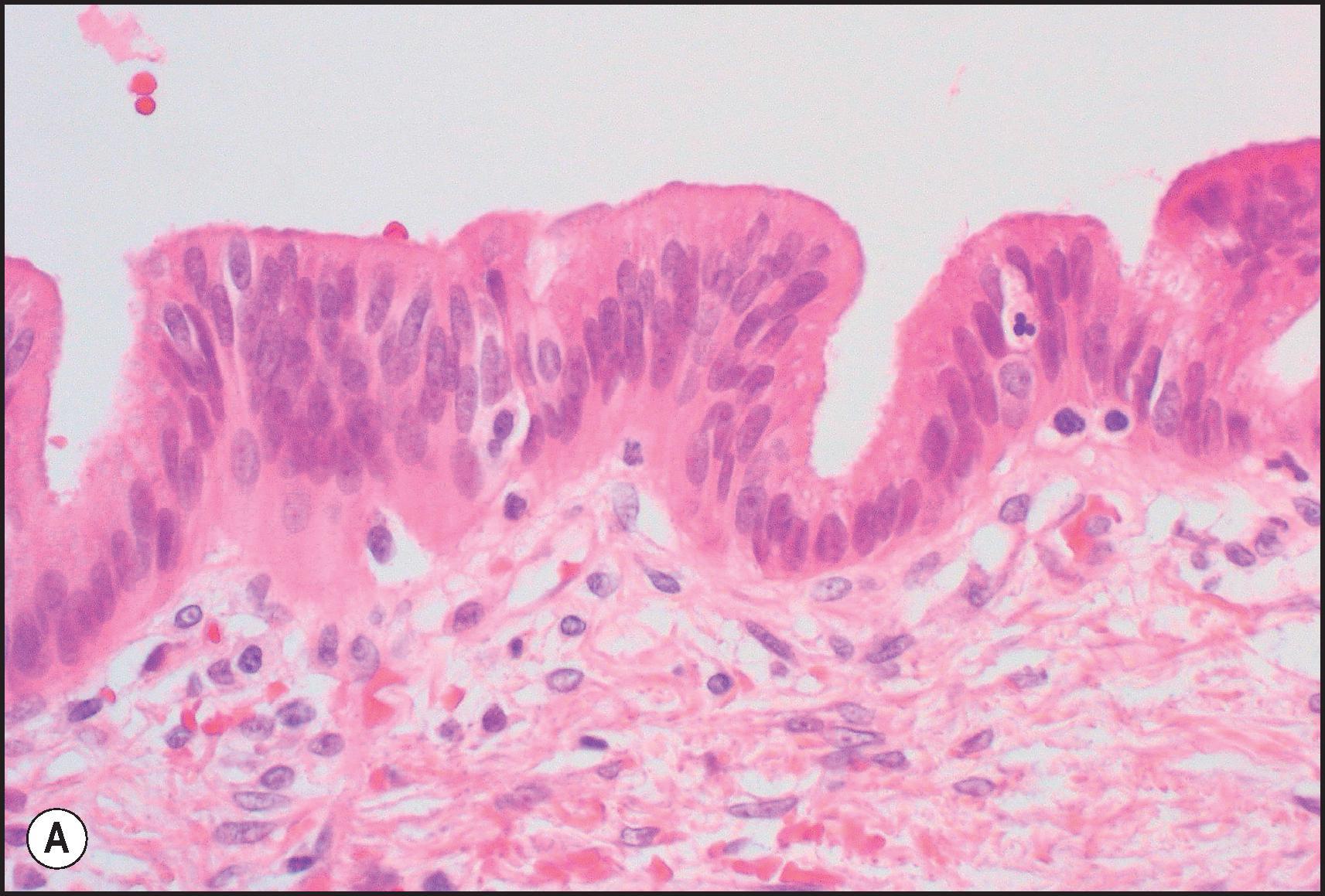
Ductopenia is defined as the absence of an appropriately sized bile duct in the portal tract. When severe inflammation is present, the duct may be obscured by numerous inflammatory cells, and immunostaining for K19 or K7 may assist with their identification. Within portal tracts, hepatic arterial branches and interlobular bile ducts of similar size run in parallel and in close proximity. This parallelism and the proportion of arteries without accompanying bile ducts in the portal tracts can be used in clinical practice to appreciate the size of affected ducts and also the degree of bile duct loss. , Ductopenia is usually defined as the absence of interlobular bile ducts in at least 50% of the portal tracts. , However, the number of complete portal tracts required to assess bile duct loss accurately has not been clearly established. Anomalous arteries without portal venous or biliary elements are occasionally encountered in the diseased or even normal livers, and such arteries should not be counted in the evaluation. Alternatively, examination of serial sections can also show actual disappearance of affected bile duct. ,
The term ‘vanishing bile duct syndrome’ (VBDS) has been used to describe a clinicopathological complex in which cholestasis is associated with loss of the intrahepatic bile ducts or ductopenia. A heterogeneous group of conditions, including immune processes, infections, drugs and ischaemia, have all been incriminated as causes of bile duct destruction in VBDS ( Box 9.3 ). VBDS may occur as an acute or subacute form evolving over months, in which ductular reaction and portal fibrosis are inconspicuous and features of acute rather than chronic cholestasis dominate the picture; examples of this include the ductopenia observed in liver allograft rejection, severe GVHD and some forms of drug-induced cholestasis. , In contrast, progressive disappearance of the bile ducts may evolve over a period of several years accompanied by changes of chronic cholestasis, porto-septal fibrosis and eventually biliary cirrhosis; this is the pattern characteristic of PBC, sclerosing cholangitides and occasionally sarcoidosis and drugs. Recovery from VBDS has been observed, especially in the liver allograft or after drug toxicity. Regrowth of the bile ducts is preceded by marginal ductular reaction. Hepatic stem or progenitor cells, presumably migrating from the periportal areas into the biliary channels, may be involved in the process.
Syndromic paucity of interlobular bile ducts
Nonsyndromic paucity of interlobular bile ducts
Extrahepatic biliary atresia (extension to intrahepatic ducts)
Progressive familial intrahepatic cholestasis
Fibropolycystic disease
α1-Antitrypsin deficiency (some cases presenting in neonates or early childhood)
Primary biliary cholangitis
Primary sclerosing cholangitis
Chronic hepatic allograft rejection ( Chapter 14 )
Chronic graft-versus-host disease (GVHD) ( Chapter 14 )
Hepatic arterial occlusion/insufficiency (ischaemic cholangiopathy)
Portal vein occlusion/insufficiency (portal biliopathy)
Bacterial (ascending cholangitis)
Protozoal (e.g. cryptosporidia, microsporidia)
Other (e.g. ruptured hydatid cyst)
Hodgkin lymphoma ( Chapter 13 and 15 )
Langerhans cell histiocytosis
Systemic mastocytosis
Paraneoplastic syndrome of malignant neoplasms
Idiopathic adulthood ductopenia
Hepatic sarcoidosis ( Chapter 15 )
Impacted erythrocytes are encountered in bile duct lumens in cases of haemobilia ( Fig. 9.9A ) or within the epithelium of the small bile ducts in liver biopsy specimens taken after recent endoscopic or surgical biliary manipulation or in association with primary or secondary malignancy ( Fig. 9.9B ).
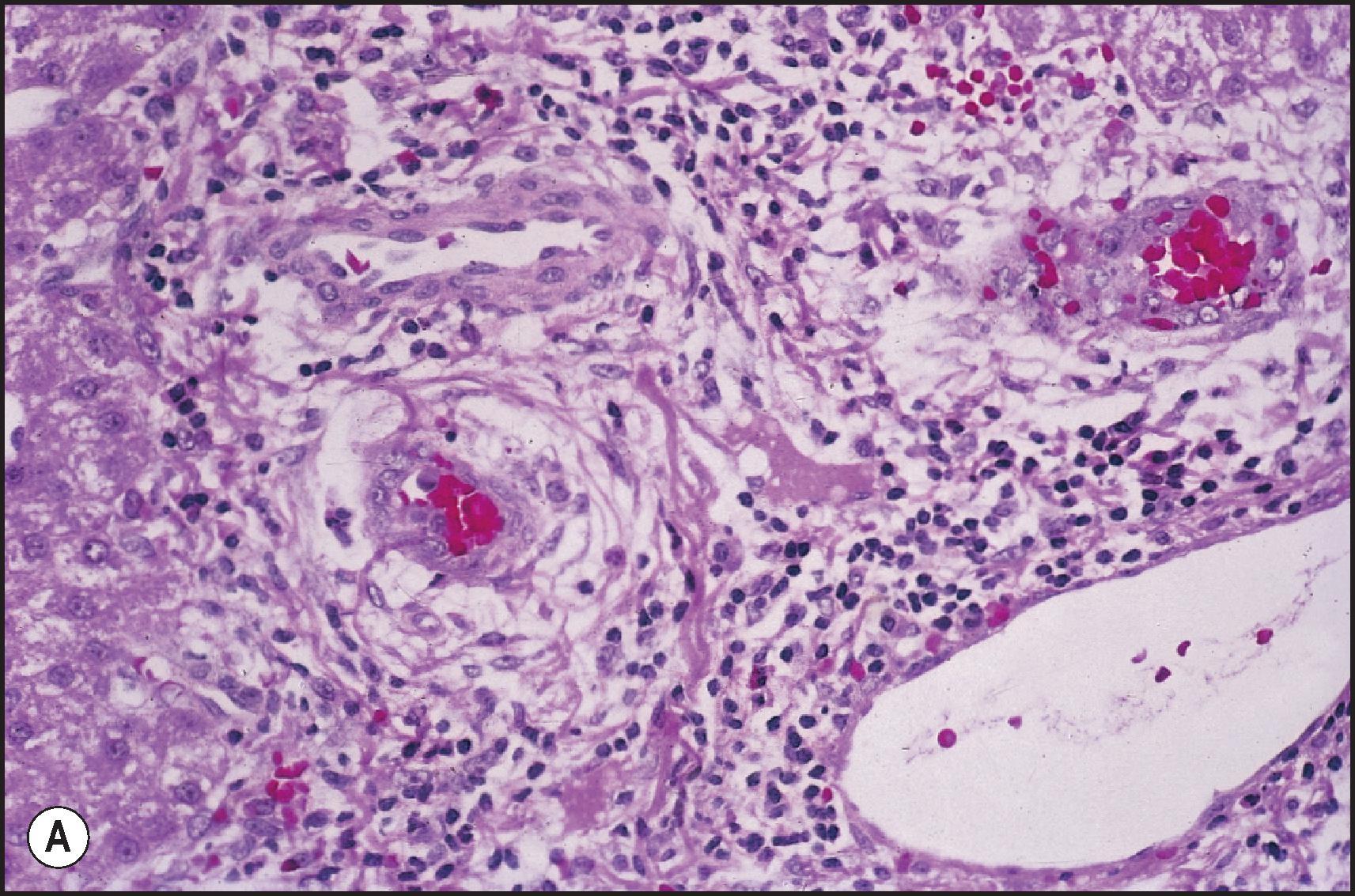
Mucin may be impacted in the duct lumen, and this is occasionally marked, leading to leakage and extravasation with the formation of mucus lakes. This feature is occasionally seen in IPNB (formerly known as ‘biliary papillomatosis’) or in other mucin-producing bile duct tumours. Similar changes are also encountered in non-neoplastic biliary diseases such as PSC and hepatolithiasis, and this lesion is occasionally lined by pleomorphic epithelium, which may be misinterpreted as carcinomatous transformation ( Fig. 9.9C, D ). Accumulation of foamy macrophages around the damaged bile ducts (xanthogranulomatous cholangitis) should be differentiated from mucin extravasation.
Cholangiopathy can be divided into several categories based on morphological and aetiological factors. Cholangitis is morphologically defined as cholangiopathy with inflammatory reactions.
Suppurative cholangitis implies the presence of numerous polymorphonuclear cells around and within the wall as well as within the lumen of bile ducts. Nonsuppurative cholangitis includes a spectrum of bile duct inflammation ( Fig. 9.10B ), which may be granulomatous, lymphocytic or sclerosing, according to the predominant type of inflammatory reaction present.
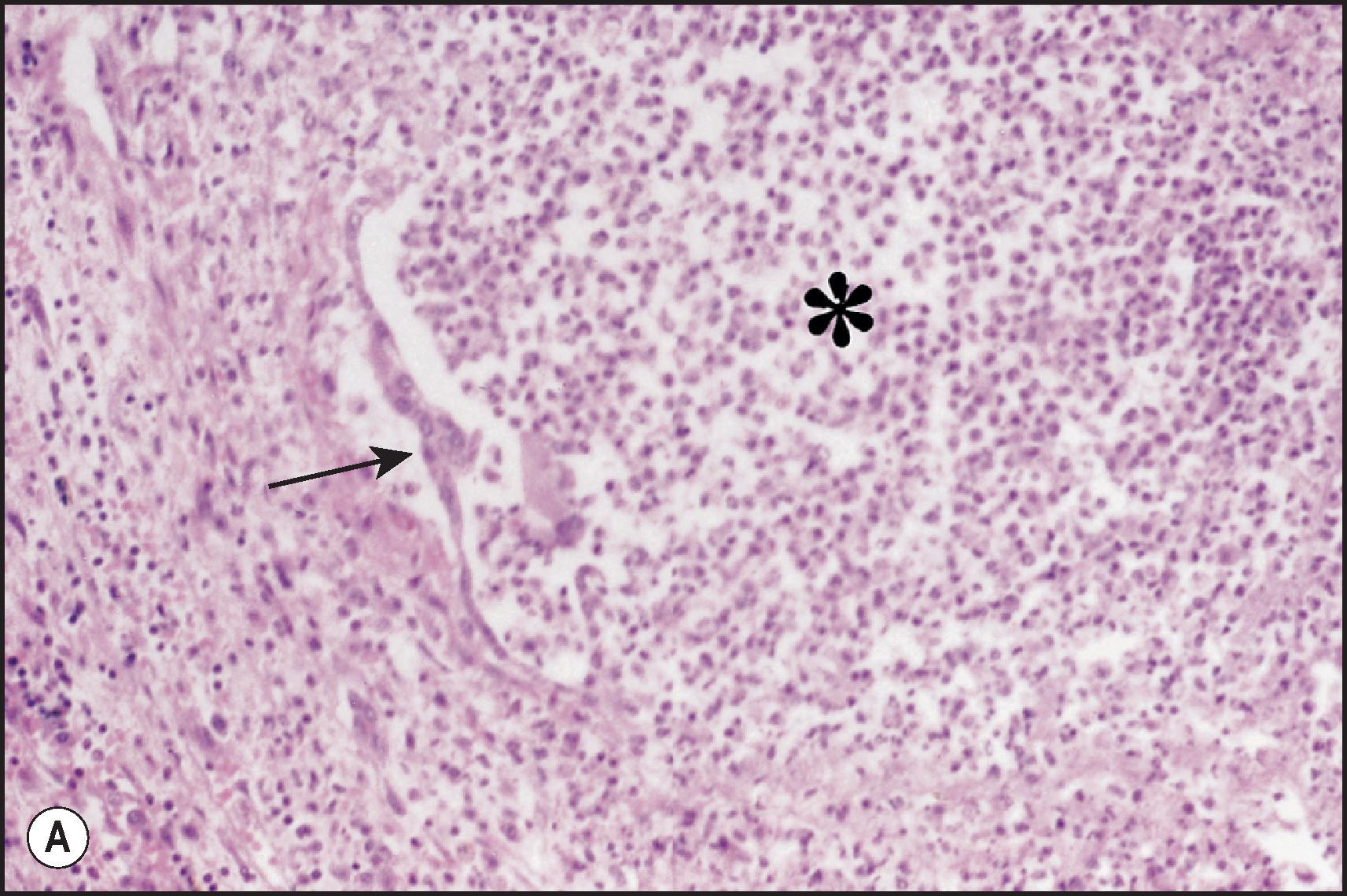
This may involve ducts of any size and is occasionally associated with abscess formation—cholangitic abscess ( Fig. 9.10A ). Microbial infection is often responsible, but the change also occurs in the presence of sterile bile, particularly after bile extravasation, where the detergent effect of the bile salts may produce a chemical cholangitis, and in the acutely rejected liver graft (rejection cholangitis) and cholangitis lenta, where the release of chemokines or cytokines is the likely cause. ,
Granulomatous cholangitis of the interlobular bile ducts constitutes the hallmark of PBC. It is also found in drug-induced liver disease and in sarcoidosis. Nonspecific biliary damage with a granulomatous or epithelioid reaction and lymphoid follicle formation occasionally occurs in livers with other longstanding biliary diseases, in particular PSC. PBC-type granulomatous cholangitis with epithelioid cells forming a mantle around the injured bile duct must be distinguished from the giant cell reaction to extravasated bile seen in nearby ruptured ducts, as in PSC and biliary obstruction ( Fig. 9.11 ).
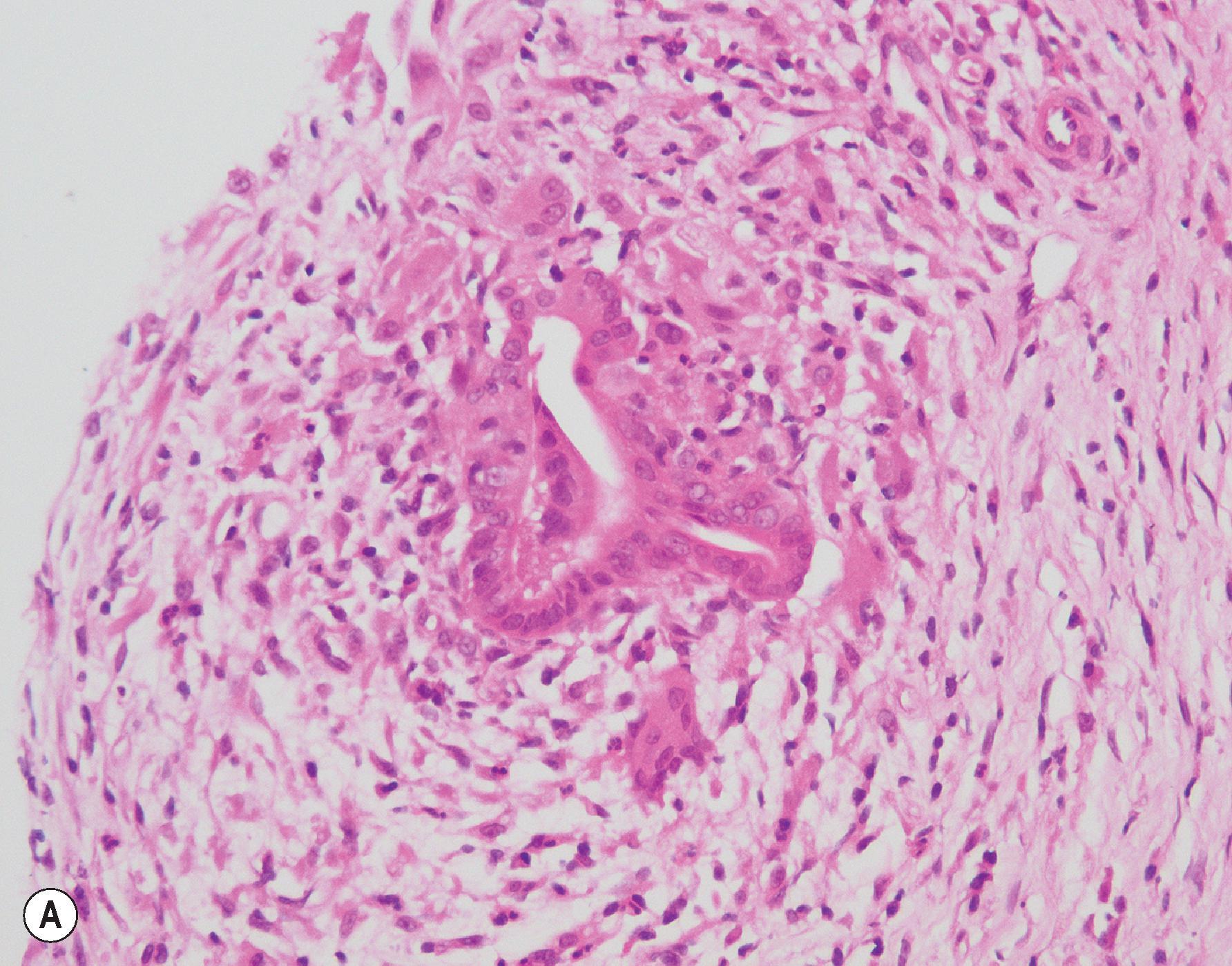
This form of cholangitis refers to a close association between duct branches, usually interlobular bile ducts, and lymphocytic aggregates, which may show a follicular arrangement. Occasionally, bile ducts are embedded in such aggregates and show epithelial injury. This is found in PBC and PSC with concomitant bile duct destruction, or in nonbiliary disorders, in particular autoimmune hepatitis (AIH) and viral hepatitis C, where progressive bile duct destruction is generally not a feature. , A variant of large-duct lymphocytic cholangitis characterized by many lymphoid follicles is referred to as ‘follicular cholangitis’.
Sclerosing cholangitis with bile duct fibrosis develops as a result of longstanding inflammatory, obstructive or ischaemic injury of the bile ducts; it can be obliterative or nonobliterative. The former is characteristic of PSC, although in our experience, it may be seen in secondary forms of sclerosing cholangitis as well. Although there are exceptions (e.g. small-duct PSC), sclerosing cholangitis generally exhibits diffuse abnormalities of the large bile ducts on cholangiogram. Progressive loss of cholangiocytes leads to replacement of ducts by fibrous cords (fibro-obliterative duct lesion). In all forms of sclerosing cholangitis, a marked attenuation of the peribiliary vascular plexus is frequently seen within the sclerotic duct wall, but it remains uncertain whether these changes are secondary to, or responsible for, the bile duct fibrosis.
PBC, PSC, GVHD and hepatic allograft rejection are examples of autoimmune- or alloimmune-mediated cholangitis. Recent studies showed that biliary atresia, particularly the acquired type, and immunoglobulin G4 (IgG4)-related sclerosing cholangitis are also associated with altered immunity. , Eosinophilic cholangitis is another form of immune-mediated condition. The level and extent of the biliary tree affected differ across and within individual diseases. The peribiliary glands are involved in PSC, GVHD and IgG4-related sclerosing cholangitis. Cholangiopathy triggered by immune checkpoint inhibitors is a drug-induced injury but can also be included in this category as the driving mechanism is thought to be related to stimulation of the host's immune system. Immunosuppression or various drugs that regulate immune reactions are currently used or tested in clinical trials for immune-mediated cholangitis.
Bacterial, fungal, parasitic and viral cholangitis may affect normal and immunocompromised hosts. , In particular, the biliary tract and the liver are prone to infestation by liver flukes such as C. sinensis and Opisthorchis viverrini , which are endemic in East Asia, especially northern Thailand and some parts of Korea (see Chapter 7 ).
Bile ducts are affected in Alagille syndrome, cystic fibrosis, fibropolycystic diseases (e.g. congenital hepatic fibrosis, Caroli disease) and MDR3 deficiency (see Chapter 3 ). Extrahepatic biliary trees are predominantly affected in pancreatobiliary malformation with or without choledochal cyst.
Although cholangiocytes have a low metabolic activity compared with hepatocytes, bile duct injury, cholangitis and ductopenia are occasionally reported in drug-induced reactions. , Drug-induced cholangiopathies (see also Chapter 12 ) often result in severe cholestasis. Variable types of cholangitis may be associated and at times lead to progressive loss of bile ducts and prolonged cholestasis. Pathogenically, some may be related to immune-mediated processes such as hypersensitivity reaction or to ischaemic damage such as floxuridine (FUDR)-induced cholangiopathy (see later). Toxic cholangiopathy has also been reported experimentally and clinically. Similar but more cytotoxic or cytopathic bile duct injury has been produced experimentally or accidentally by α-naphthylisothiocyanate, 4,4′-diaminodiphenyl methane or paraquat. ,
The peribiliary vascular plexus is essentially supplied by branches of the hepatic artery, which makes the bile ducts, unlike the parenchyma, particularly vulnerable to any interference with arterial flow. The small constituent vessels are well demonstrated by immunostaining for CD34 or factor VIII-related antigen ( Fig. 9.12 ). They form a three-layer plexus around the extrahepatic, large intrahepatic and septal bile ducts, with the small portal vein branches and small arteries around the bile ducts (peribiliary arteries) being included in the outer layer. This organization becomes less evident around the interlobular bile duct and ductules, which nevertheless remain entirely dependent on arterial blood. Primary and secondary damage to the hepatic arterial branches or to the peribiliary vascular plexus itself, whether from thrombotic occlusion, foam cell arteriopathy or vasculitis, may lead to ischaemic cholangiopathy. , This may take the form of cholangiocyte damage or cholangitis without necrosis and bile duct fibrosis. Erosion, focal necrosis or infarction of bile ducts and extravasation of bile (biloma) may ensue. Constituent vessels of the perivascular plexus may be affected variably. Ductopenia, biliary stricture and cholangiectasis are common complications, with infection often developing in the devascularized tissue. The biliary tree in allografts is particularly susceptible to ischaemia because of a lack of vascular collaterals in the early post-transplant period (see Chapter 14 ). Necrotizing arteritis (polyarteritis nodosa) of hepatic arterial branches and microvascular occlusion from sickle cell disease are rare causes of ischaemic bile duct injury. ,
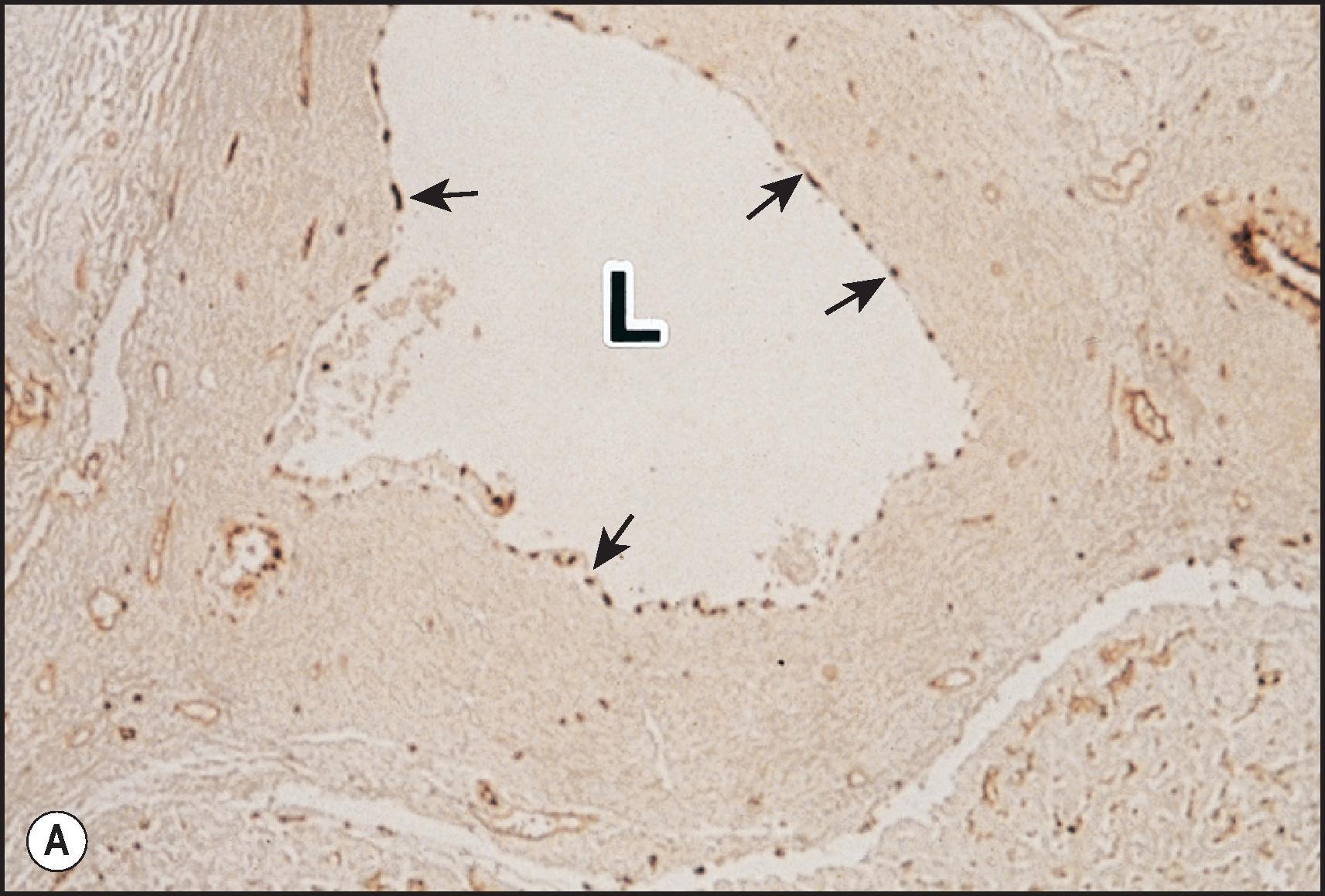
The human biliary tree is sterile under normal conditions, yet bacterial components such as pathogen-associated molecular patterns (PAMPs), including lipopolysaccharide (LPS) and bacterial DNA from intestinal flora, are detectable in bile and cholangiocytes in chronic inflammatory biliary diseases, and even in normal bile. Cholangiocytes are also consistently exposed to bile contents, including toxic hydrophobic bile acids. To prevent unnecessary inflammatory responses, the biliary tract is equipped with tightly regulated defence mechanisms, which are physical (bile flow, biliary mucus), chemical (bile salts) and immunological (secretory IgA). ,
In the biliary tree from the intrahepatic septal to extrahepatic bile ducts, cholangiocytes contain mucin droplets in the supranuclear cytoplasm, and the mucin secreted into the duct lumen serves as a barrier against unfriendly bile constituents. Another protective mechanism against toxic hydrophobic bile acids is called the ‘bicarbonate (HCO 3 − ) umbrella’. Cholangiocytes secrete HCO 3 − through anion exchanger 2 (AE2), which contributes to the maintenance of a high pH on the apical surface of the biliary epithelium. The alkaline environment inhibits bile acid uptake and toxicity in cholangiocytes ( Fig. 9.13A ).
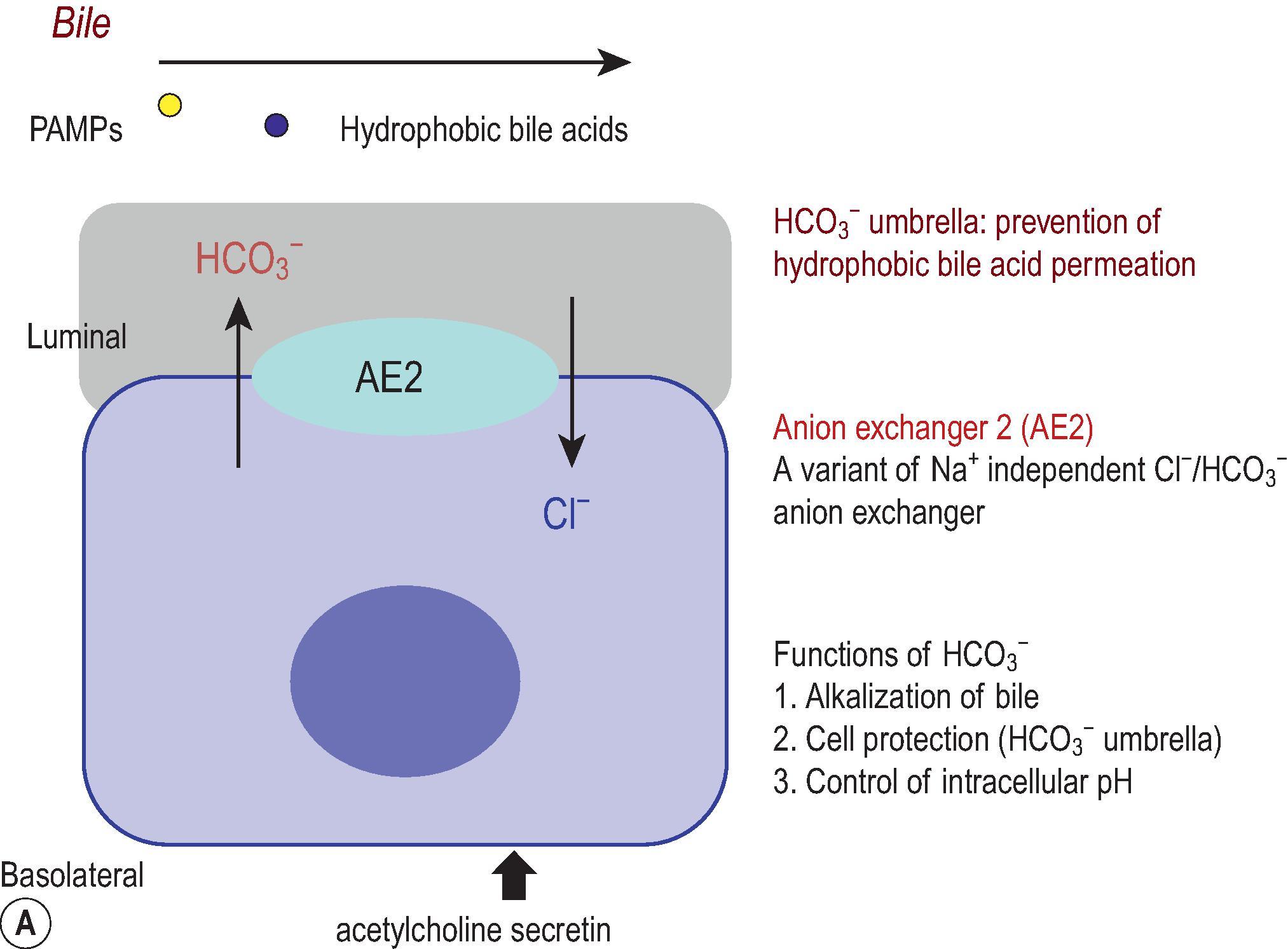
Nonspecific bactericidal enzymes such as lactoferrin and lysozyme are demonstrated in the intrahepatic biliary tree and bile. Human β-defensins (hBDs) and cathelicidin, antimicrobial peptides contributing to innate immunity at mucosal surfaces, are expressed in the biliary tract; hBD1 is constitutively expressed in biliary epithelium, while hBD2 is upregulated in large intrahepatic bile ducts in extrahepatic biliary obstruction, hepatolithiasis and to a lesser degree in PBC and PSC ( Fig. 9.13B ). , Cathelicidin is expressed by normal cholangiocytes in addition to hepatocytes. Moreover, bile salts including chenodeoxycholic acid and ursodeoxycholic acid (UDCA) enhance cathelicidin expression through the farnesoid X receptor (FXR) and the vitamin D receptor. Trefoil factor family (TFF) peptides expressed at the apical surface of the epithelium play a major role in mucosal repair.
Although human bile contains several PAMPs in normal as well as diseased livers, PAMPs physiologically do not elicit an inflammatory response in the biliary tree, suggesting that tolerance against commensal PAMPs is important in maintaining the homeostasis of biliary innate immunity. Toll-like receptors (TLRs), which are involved in the recognition of PAMPs, are expressed in normal and damaged cholangiocytes ( Fig. 9.13C ). Bile ducts express TLRs 2, 3, 4 and 5, which bind to ligands, such as PAMPs, double-stranded RNA, LPS and flagellin, respectively. Evidence for the maintenance of tolerance by cholangiocytes was demonstrated by the upregulation of interleukin-1 receptor-associated kinase M (IRAK-M), a negative regulator of TLR signalling, in isolated human cholangiocytes on stimulation with TLR2 and TLR4. Peroxisome proliferator activating receptor γ (PPARγ), another negative regulator of intracellular TLR signalling, is also associated with the endotoxin tolerance in cholangiocytes.
Immunoglobulin A is known to be secreted into bile by binding with the secretory component. Secretory IgA (sIgA) functions in a number of ways to protect the biliary tract; it can directly bind and neutralize bacterial toxins and can bind to bacteria and prevent their adhesion to the mucosal membrane. Also, IgA has been demonstrated to neutralize intracellular microbes and their products. Biliary intraepithelial lymphocytes, which are greatly increased in immune-mediated cholangitis, are occasionally encountered in normal intrahepatic bile ducts. Most intraepithelial lymphocytes of bile ducts are positive for CD8, and some are CD57 positive; these cells may participate in biliary innate immunity.
Disruption of the defence system may contribute to the development and progression of biliary diseases. The distribution of the relevant molecules along the intrahepatic biliary tree is schematically shown in Fig. 9.13D .
The immune process is targeted against allo- or autoantigens that may be abnormally or aberrantly expressed in the bile ducts or absorbed from the bile and deposited in the cholangiocytes. The alloimmune response preferentially affects the interlobular bile ducts. In liver allograft rejection the recipient's immune response is directed against allogeneic antigens (peptide antigens presented by allogeneic MHC or allogeneic MHC antigens themselves) on the donor bile ducts. In GVHD, MHC-related antigens induced on the bile ducts by locally released cytokines or viral infections are targeted by grafted lymphoid cells. Antimitochondrial antibodies (AMAs) are detected against pyruvate dehydrogenase complex E2 subunit (PDC-E2) in PBC. They may cross-react with exogenous microbial components such as LPS, which bear a molecular mimicry for PDC-E2. , In PSC, cross-reactive peptides shared by biliary and colonic epithelium and bacterial antigens have been proposed as possible targets. , Increased expression of both heat shock protein 60 (HSP60) and lipid A, a constituent of endotoxin, has been demonstrated in the cholangiocytes in PBC and PSC. , In addition, cholangiocytes contain antigenic substances such as carbonic anhydrase II, against which autoantibodies have been detected in sera of patients with immune-mediated cholangitis. ,
Two types of antigen-presenting cells (APCs), professional and nonprofessional, of which cholangiocytes are a possible example, may be involved in immune-mediated cholangitis. Professional APCs, especially dendritic cells and to a lesser degree macrophages, are the most important regulators of initial T-cell activation. Dendritic cells that express B7, human leukocyte antigen–DR isotype (HLA-DR) and S100 molecules are observed around and occasionally within the epithelial layer of damaged bile ducts ( Figs 9.14 and 9.15A, B ). At least two molecules, B7-1 and B7-2, work as co-stimulatory ligands for CD28 expressed on surrounding T cells. Focal staining for B7-2 on the bile ducts expressing aberrantly HLA-DR suggests that cholangiocytes may present self-antigens, although this issue is still controversial.
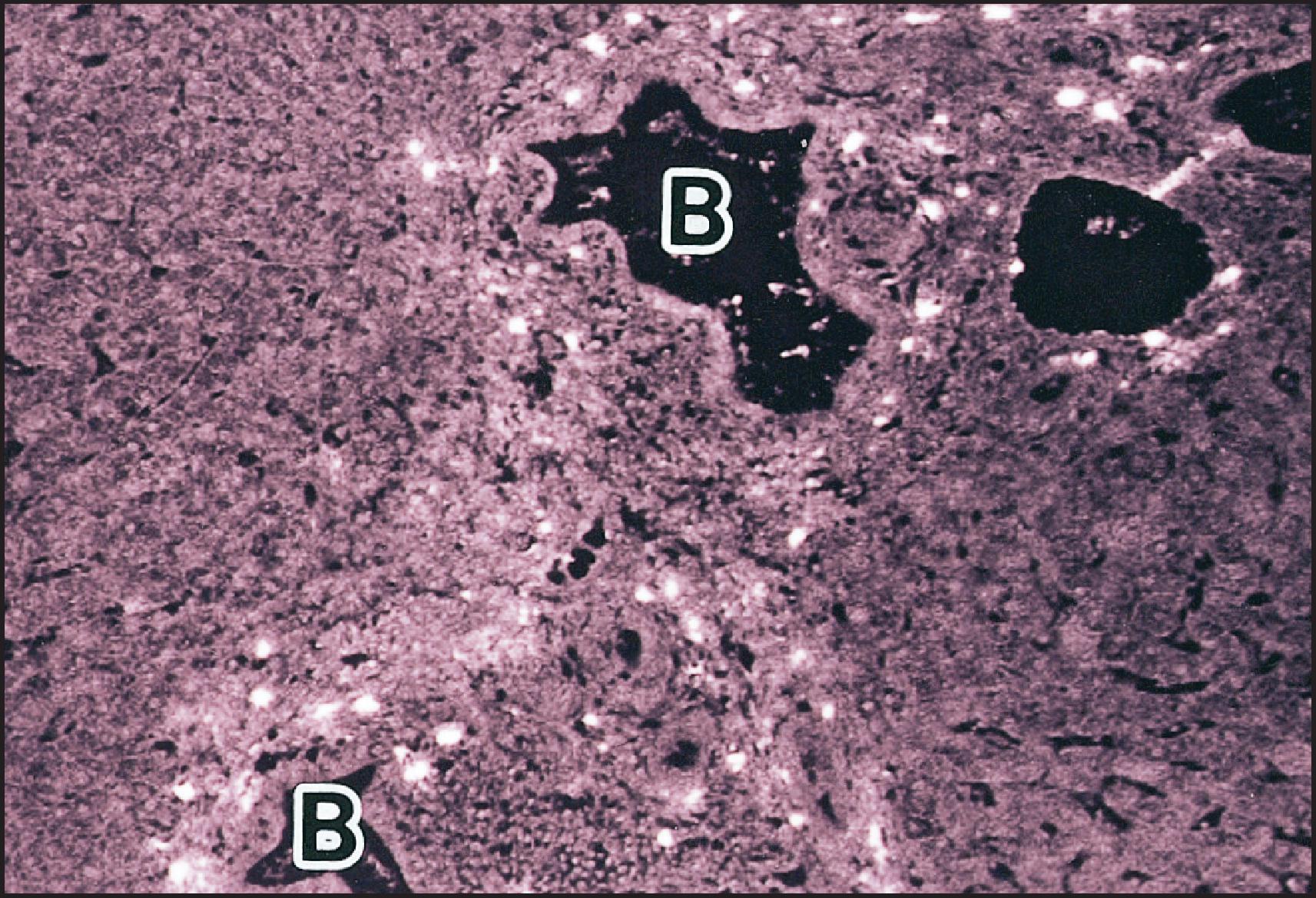
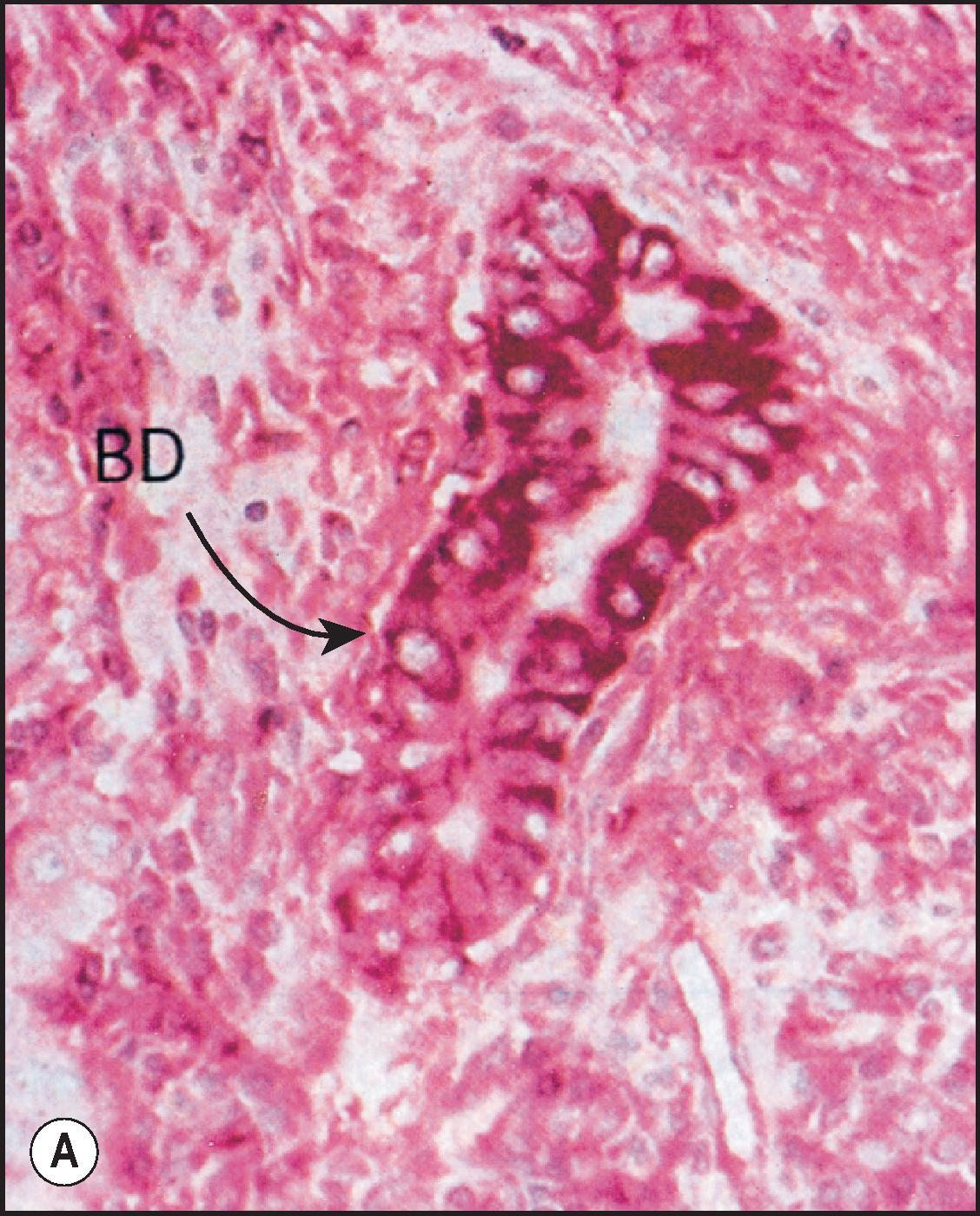
In addition to being the main target of immune-mediated cholangitis, bile ducts participate actively and passively in accumulation, activation and proliferation of immunocompetent cells. Expression and secretion of cytokines, chemokines and their receptors by multiple cell types around the damaged bile ducts as well as by cholangiocytes themselves are central to the progression of bile duct injury. , However, a triggering event that damages the bile ducts or changes the inflammatory microenvironments of the portal tract is required to start the process in genetically susceptible individuals.
The bile ducts interact with members of the immune system in a number of ways. Cholangiocytes, particularly in small bile ducts, express constitutively low levels of surface immune molecules such as MHC class I; very late antigen (VLA) 2, 3 and 6; intercellular adhesion molecule 1 (ICAM1) and lymphocyte-associated antigen 3 (LFA3). , Importantly, during an inflammatory response, cholangiocytes upregulate their expression of these molecules. This is shown by the addition of inflammatory cytokines (e.g. tumour necrosis factor-α [TNF-α], interleukin 1 [IL-1], interferon-γ [IFN-γ]) to culture systems. , Local release of cytokines, particularly IFN-γ, TNF-α and chemokines, also induces and upregulates the bile duct expression of MHC class II ( Fig. 9.15A, B ), ICAM1, LFA3 and vascular cell adhesion molecule 1 (VCAM1) ( Fig. 9.15C, D ). LFA3 on cholangiocytes can interact with CD2 molecules on killer T cells, and VCAM1 binds to VLA4 on leukocytes. Overall, the increase in leukocyte adhesion molecules facilitates tissue-specific migration by slowing down leukocyte circulation around the damaged epithelium, promoting trafficking to the target site. Human cholangiocytes also constitutively express IL-6, IL-8 and monocyte chemotactic protein 1 (MCP1), which are important chemotactic agents for neutrophils, monocytes and T cells. , ,
Induction and upregulation of immune molecules also occur on the adjacent microvasculature and lead to recruitment of more inflammatory cells. The leukocytes, which accumulate around the bile ducts, express integrins, LFA1 and VLA4. They migrate from the peribiliary vascular plexus, whose constituent capillaries strongly express chemokine-induced adhesion molecules (ICAM1, VCAM1 and ELAM1/E-selectin), which secures extravasation and localization of inflammatory cells. The process facilitates cell positioning or adhesion around the bile ducts, antigen presentation, co-stimulatory signalling and activation of antigen-specific CD4+ T cells. After migration, the immunocompetent cells must penetrate into the bile duct epithelium, epitheliotropism ( Fig. 9.16A ). The presence on duct basement membranes of binding sites for lymphocyte receptors and the upregulation of integrins and other adhesion molecules facilitate the process. , The surface expression of ICAM1, LFA3 and VCAM1 on cholangiocytes ( Fig. 9.15C, D ) suggests linkages between damaged bile ducts and lymphocytes which secure antigen presentation to periductal lymphocytes and trigger effector mechanisms. , Point and broad contacts between infiltrating lymphocytes and both biliary epithelium and extracellular matrix are demonstrated ultrastructurally, and such interactions appear to involve binding of CX3CR1 to fractalkine, which is upregulated in injured bile duct epithelium. ,
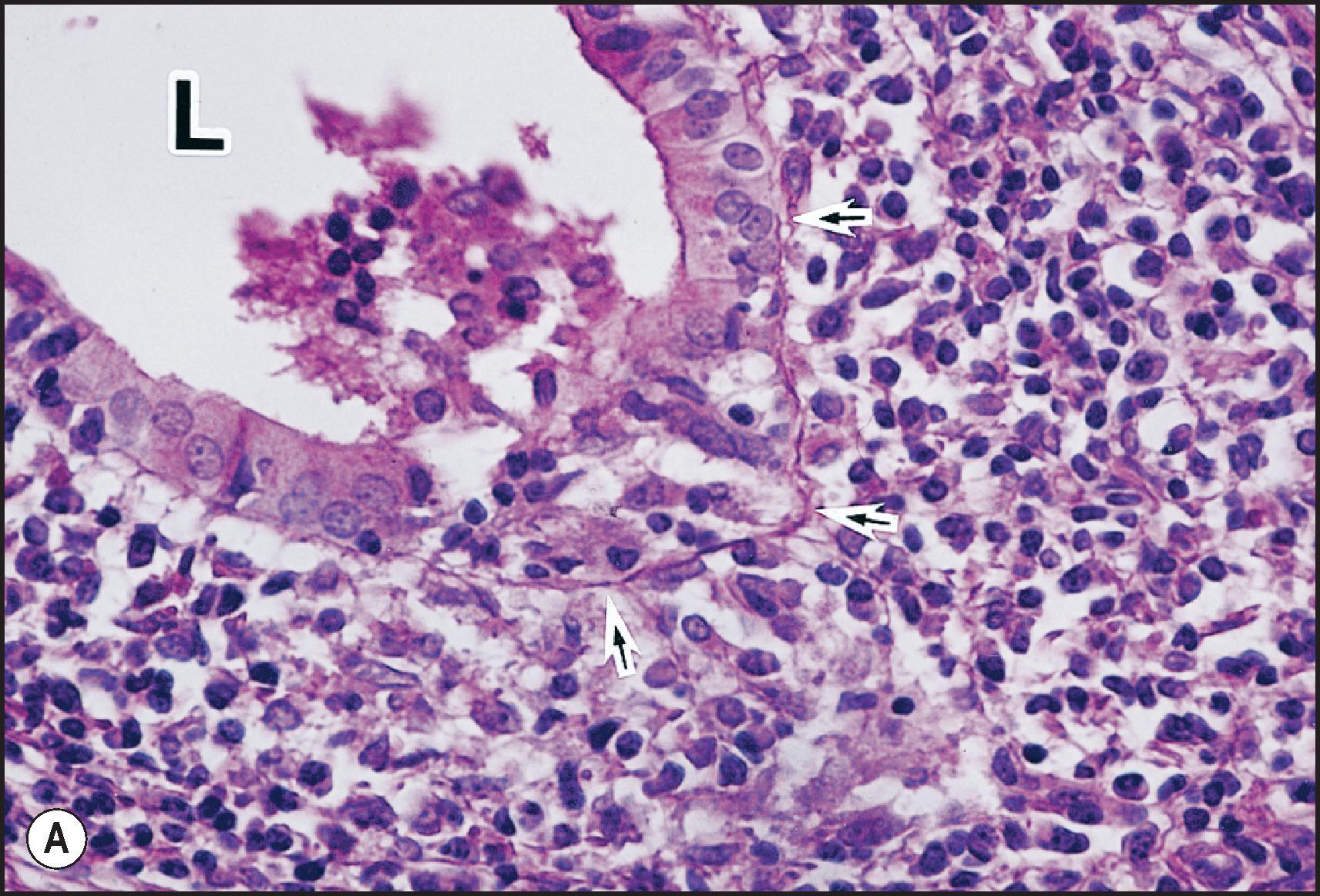
Along with the breakdown of self-tolerance, the relative strength of helper T-cell type 1 (Th1) and type 2 (Th2) responses and the resultant cytokine milieu are determinants for the characterization and continuation of bile duct damage. In PBC, PSC and liver allograft rejection, there is a predominance of Th1 subsets, which produce IL-2 and IFN-γ and stimulate both the proliferation of cytotoxic T lymphocytes and the local production of IFN-γ and TNF-α. The latter are known to induce and upregulate the expression of MHC class I and II and adhesion molecules on the bile ducts. , Expressions of IL-5, IL-6 and transforming growth factor-β (TGF-β) are also noted in the majority of cases of immune-mediated cholangitis. These alterations in the cytokine milieu are supposed to contribute to antibody production by B lymphocytes. Unlike classic autoimmune biliary diseases, Th2 predominance is a characteristic feature in IgG4-related sclerosing cholangitis, where the combined overproduction of IL-4 and IL-10 is thought to play a central role in IgG4 induction.
Tregs are important for the regulation of immune-mediated cholangitis and play a critical role in self-tolerance. One study showed that FoxP3-expressing Tregs were lower in PBC portal tracts than in chronic hepatitis C and AIH; a deficiency in Tregs was also found in daughters and sisters of PBC patients when compared with controls. However, another study showed that the amounts of infiltrating FoxP3+ Tregs in portal tracts were similar in PBC and chronic viral hepatitis and correlated with the degree of portal inflammation regardless of the disease. Interestingly, the Treg population is increased in the bile duct lesions of IgG4-related sclerosing cholangitis.
The initiation of apoptosis, a major form of cell death in immune-mediated cholangiopathy, may occur through different yet interrelated mechanisms, as follows:
Direct cytotoxicity by CD4+ and CD8+ T cells; the former are mainly dependent on the Fas/Fas ligand (FasL) interaction, whereas the latter rely on the perforin–granzyme exocytosis pathway. Most cytotoxic T lymphocytes in allograft rejection are MHC class I-restricted CD8+ T cells, while CD4+ cells belonging mainly to the Th1 subset predominate in PBC and PSC. , These T cells may recognize PDC-E2.
Activation of the Fas receptor (FasR)/FasL system is the best-studied model of apoptosis. In PBC, PSC and allograft rejection, FasR is strongly expressed on the damaged bile duct cells ( Fig. 9.16B ), which are surrounded or infiltrated by FasL-expressing cytotoxic T cells of Th1 subset. The exact stimuli for FasR expression on the bile duct epithelium may vary with individual diseases.
The occurrence of apoptotic cell death through TNF-α is supported by the expression of both mRNA and protein for the TNF-α and TNF-α receptor on damaged bile ducts. , The expression of TNF-related apoptosis-inducing ligand (TRAIL) by damaged bile ducts in PBC and PSC may be an attempt by cholangiocytes to control the inflammatory responses by targeting death receptor (DR)-expressing leukocytes.
Serum autoantibodies are detected in PBC and PSC, but it remains debatable whether AMA or centromere-type antinuclear antibodies (ANAs) in PBC and ANA or perinuclear antineutrophil cytoplasmic antibodies (pANCAs) in PSC have a pathogenetic role. A majority of the plasma cells infiltrating the portal tracts in PBC secrete AMAs of IgG, IgA and IgM classes, and these antibodies may be involved in antibody-dependent cytotoxicity. CD20+ B cells and immunoglobulin-positive cells detected in the portal areas may result from a proliferation of autoreactive B cells stimulated by CD4+ T cells of Th2 subset. , The demonstration of selective caspase activation by dimeric IgA with specificity for the PDC-E2 component of AMA in an in vitro cell line transfected with human polymeric immunoglobulin receptor may support a pathogenetic role of AMA in bile duct injury of PBC.
In liver allograft rejection and GVHD, preformed antidonor MHC class I antibodies and antibodies directed against major ABO blood group antigens, which are normally expressed on the bile ducts, may be responsible for antibody binding and complement-fixing damage.
There is good evidence that genetically determined abnormalities of immunoregulation play a role in the development of bile duct damage in PBC and PSC. Several HLA haplotypes are known to increase the risk of PBC and PSC. , Deficiency in Tregs found in daughters and sisters of PBC patients suggest that genetic predisposition exists before disease development. Although recent genome-wide association studies (GWASs) have identified non-HLA susceptibility loci for biliary disorders, many of them have previously been detected in other conditions, suggesting that risk loci detected by GWASs are likely to represent broad phenotypic features such as inflammation rather than disease-specific affections. Genetic factors, in addition to HLA disparity, are also likely determinants of whether individuals will be strong or weak rejectors after liver grafting, but none has been specifically identified, except for non-White recipients being at increased risk for graft rejection.
Infection: Bacterial or viral infections may play a primary or secondary role in the progression of immune-mediated bile duct injury. Bacteria, particularly enterobacteria, have been implicated in the progression of PBC, PSC and hepatolithiasis. , Bacterial or viral infections may aggravate or initiate the alloimmune-mediated bile duct lesions in GVHD and hepatic allograft rejection. Cytomegalovirus (CMV) infection has been shown to increase the risk of ductopenic rejection, although the pathogenetic role of CMV in this regard remains in doubt. , Hepatitis C infection and treatment with IFN-α may predispose to the development of ductopenic rejection after liver transplantation (LT).
Hydrophobic bile acids: Normally, the biliary epithelium is protected against the detergent effects of bile acids by phospholipids, resulting from the incorporation of the bile acids into mixed micelles with phospholipids and cholesterol. The detergent power of bile acids augments with increasing relative hydrophobicity of bile acids. Endogenous hydrophobic bile acids may enhance the bile duct lesion by dissolving membrane lipids or stripping key hydrophobic proteins off the outer layer of the apical membrane of cholangiocytes and by promoting apoptosis. ,
Oxidative stress: Reactive oxygen species (ROS) generated in the biliary epithelium and also by inflammatory cells around and within the bile ducts may be responsible for apoptosis and cellular senescence of cholangiocytes in PBC and allograft rejection. , ,
Eosinophils: In acute liver allograft rejection, particularly acute antibody-mediated rejection, and to a lesser degree in PBC and PSC at early stages, there is a marked eosinophil infiltration in portal tracts with widespread deposition of eosinophil cationic protein granules known to be cytotoxic for bile ducts. Blood eosinophilia may be associated with this infiltrate. Eosinophils are correlated with an upregulation of eosinophil chemotactic factor IL-5. Eosinophils are also prominent in IgG4-related sclerosing cholangitis.
The complex mechanisms of bile secretion are described in Chapter 1 . Cholestasis denotes a defect in bile secretory mechanisms leading to an accumulation in the blood of substances normally excreted in the bile— biochemical cholestasis . This is often but not invariably associated with deposition of bile in the liver, which can be visualized microscopically— morphological cholestasis . Mechanical or obstructive cholestasis usually refers to lesions of the extrahepatic biliary tract (extrahepatic cholestasis) but is occasionally produced by intrahepatic processes that cause jaundice only when the flow is compromised in the majority of the intrahepatic biliary passages, as in the late stage of PBC. Although mechanical obstruction thus clearly contributes to cholestasis originating within the anatomical confines of the liver, most use the term ‘intrahepatic cholestasis’ to indicate cholestatic syndromes without demonstrable mechanical obstruction. Such functional intrahepatic cholestasis is common to a number of parenchymal injuries of various aetiologies, when complex metabolic alterations at the level of the hepatocyte produce an abnormally thick bile that becomes inspissated in the canaliculi, first and predominantly in the perivenular region.
There may be a striking discrepancy between morphological and clinical/biochemical cholestasis. Conditions that are clinically cholestatic and considered as primarily biliary diseases may progress without evident accumulation of bile pigment on biopsy. This is mainly the case in partial obstruction or destruction of the biliary passages, as in the early stages of PBC and PSC. In this situation the patient experiences pruritus and shows biochemical signs of cholestasis, such as elevated serum alkaline phosphatase (ALP), γ-glutamyltransferase (GGT), cholesterol and bile acids, whereas the level of conjugated bilirubin remains normal or is only marginally raised and remains so until the disease is well advanced. Morphologically, this preicteric phase is characterized by changes at the portal or portoseptal interface (biliary interface activity).
Microscopically, cholestasis of any aetiology is characterized by an exclusively or predominantly perivenular localization of bilirubin deposition in hepatocytes, inspissated bile in dilated canaliculi and variable degree of bile regurgitation into the perisinusoidal space with phagocytosis by Kupffer cells ( Fig. 9.17 ). This may be more correctly described as ‘bilirubinostasis’, although products other than the bilirubin are concomitantly retained but not readily visualized microscopically. In severe cholestasis or in cholestasis of longer duration, such pigment deposition may extend to the periportal region, and cholestatic or biliary liver cell rosettes may develop. These are particularly common in children and consist of dilated canaliculi surrounded by more than two hepatocytes in a pseudotubular arrangement (cholestatic rosettes) ( Fig. 9.18A ). The rosettes express some biliary keratins ( Fig. 9.18B ) and on 3D reconstruction are found to communicate with bile ducts and ductules. The predominantly perivenular localization of bilirubinostasis may be explained by both the lower oxygen tension in the perivenular region and the fact that bile acid secretion and corresponding bile water flow are regulated by mechanisms different from those responsible for bilirubin secretion. Since the periportal zone is the main contributor to ‘bile acid-dependent’ bile flow, the canaliculi of the perivenular zones are perfused with a smaller amount of fluid generated by mechanisms progressively independent of bile acids as one approaches the hepatic venule. Such zonal differences predispose to a primarily perivenular distribution of canalicular precipitates during cholestasis of any cause.
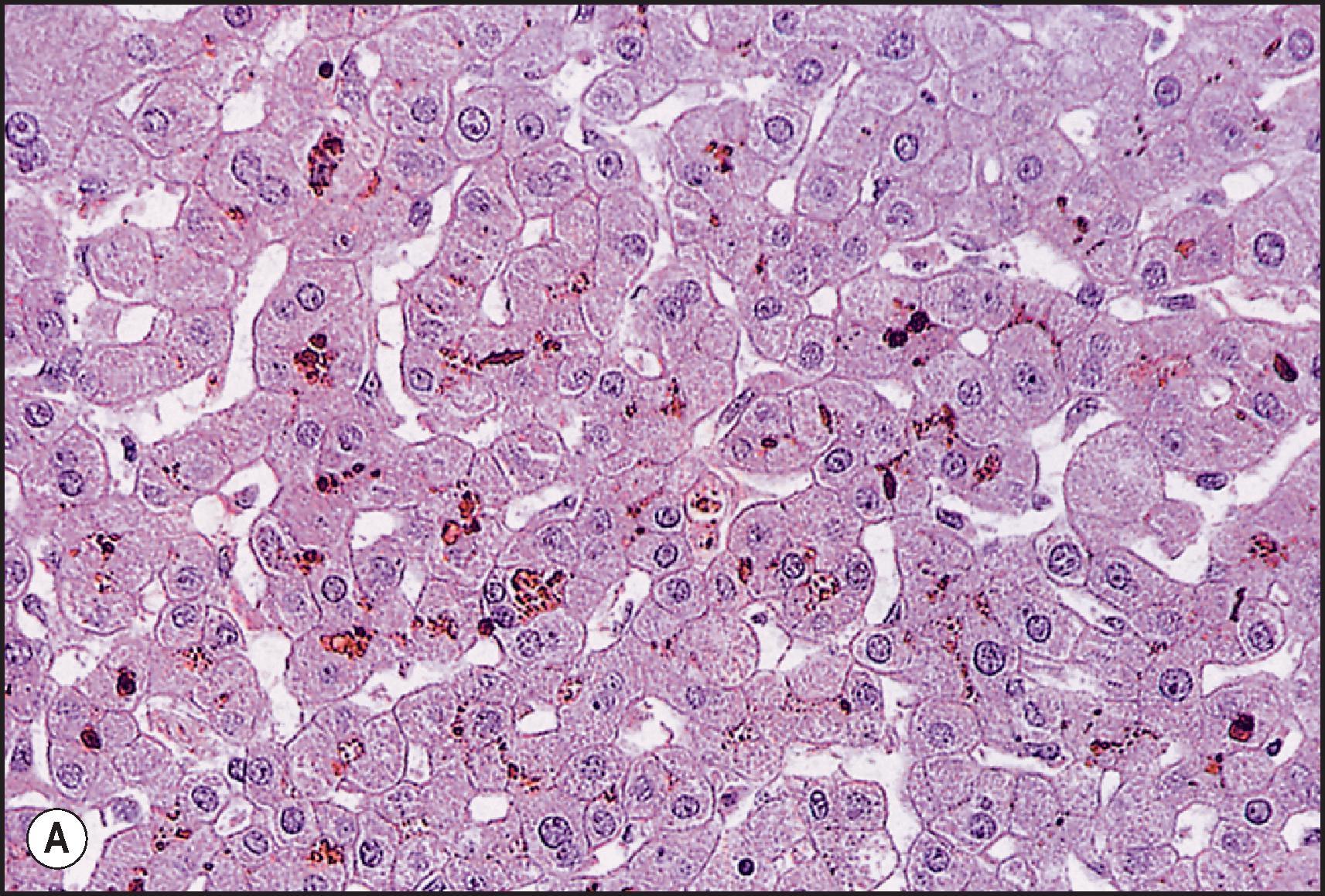

In addition to bilirubinostasis, cholestasis is associated with changes in staining patterns of various enzymes. In particular, the basolateral membrane of the hepatocyte acquires microvilli that show a positive reaction for Mg 2+ -ATPase, whereas this has disappeared in the canalicular membrane. The pattern suggests a reverse secretory polarity, as confirmed by the demonstration of the canalicular bile salt export carrier on the basolateral membrane. The latter also shows a striking increase in histochemically demonstrable serum ALP and GGT, possibly from a high local concentration in detergent bile acids causing release of these enzymes from the liver cell membrane.
On electron microscopy, cholestasis is recognized by a typical pattern of changes in and around the canaliculi ( Figs 9.19 and 9.20 ), even in the absence of any visible bile pigment accumulation on light microscopy. The canaliculi are variably dilated with a loss of microvilli, and their lumen may be filled with electron-dense material representing bile concretions. However, the tight junctions are preserved; the pericanalicular ectoplasm is thickened, and the hepatocytes show dilated endoplasmic reticulum, with the presence of vacuoles containing whorled membranous material and lipofuscin inclusions. Mitochondria exhibit curled or circular cristae.
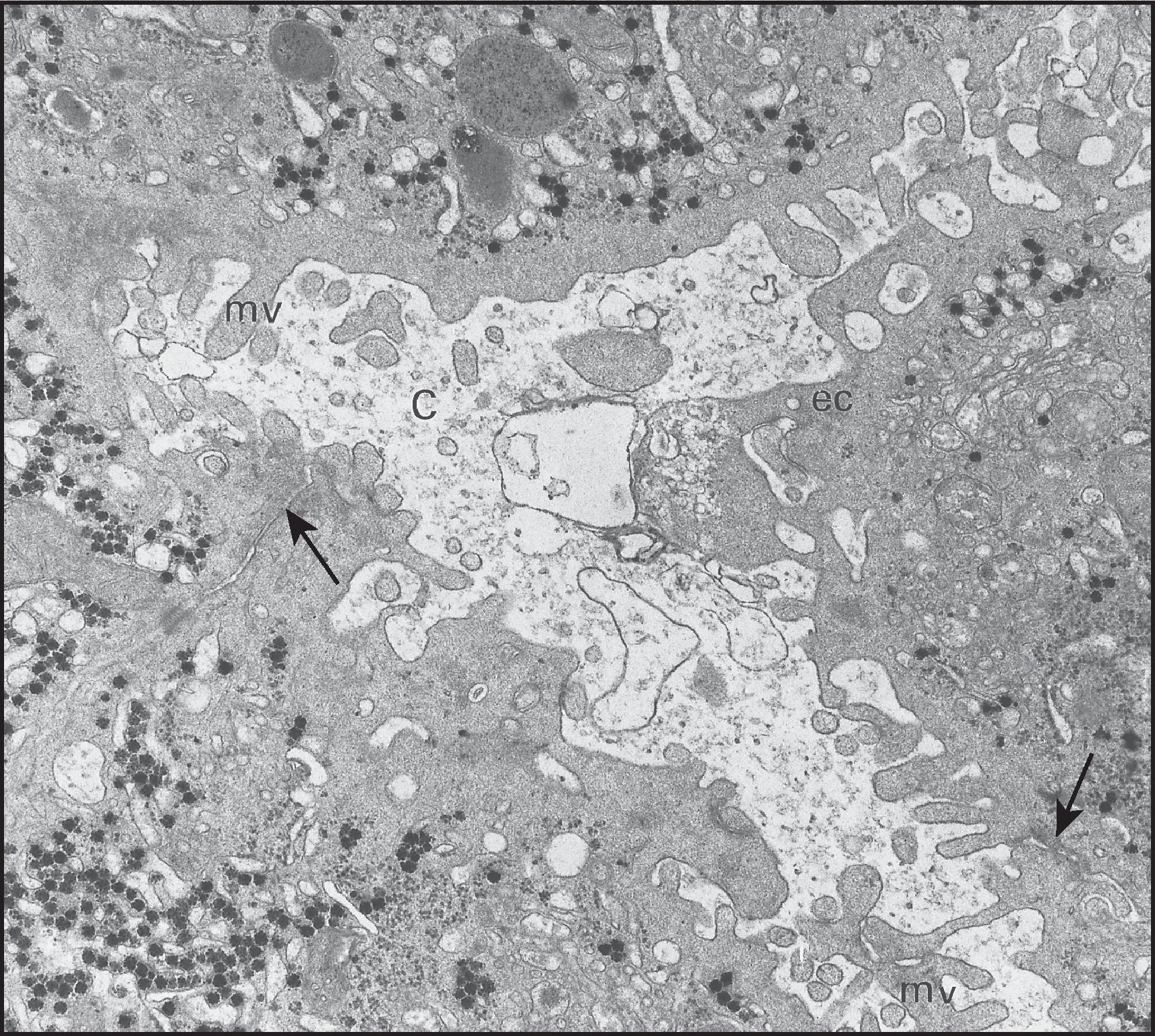
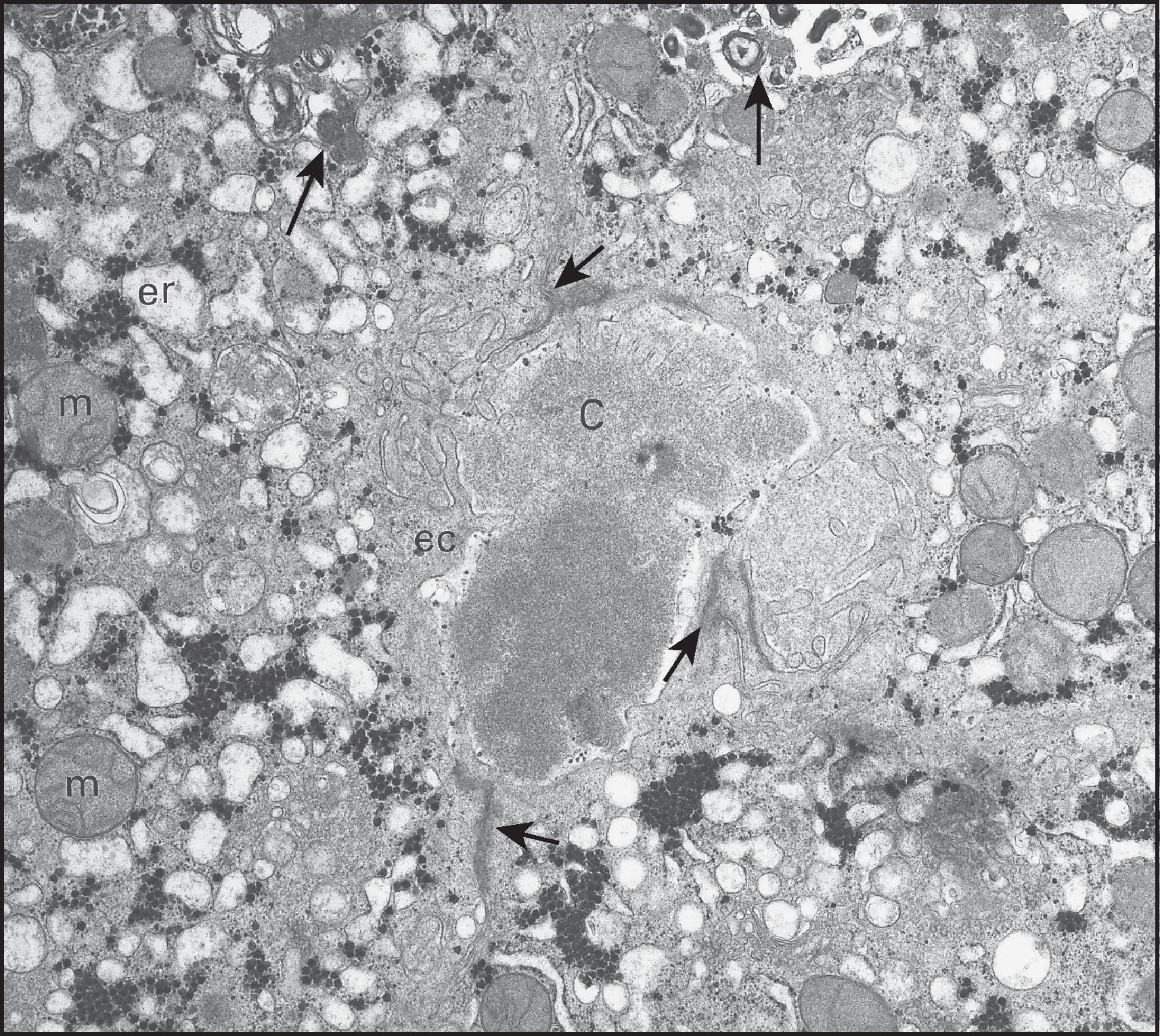
Biliary interface activity, previously known as ‘biliary piecemeal necrosis’, refers to a disruption of the parenchymal limiting plates by a complex process which includes cholate stasis, ductular reaction and fibrosis in variable combinations ( Figs 9.21 and 9.22A–C ). The recognition of biliary interface activity is important because in the absence of cholestasis and of characteristic bile duct injury, it is the main clue to diagnosing a primarily biliary disorder. The two main components, cholate stasis and ductular reaction, are discussed separately because either may dominate the picture and evolve distinctively, which may reflect the severity and duration of interference with bile flow, or at times for no obvious reason. Fibrosis invariably develops when cholate stasis and ductular reaction persist.
![Figure 9.21, Biliary interface activity in primary biliary cholangitis. (A) Cholate stasis; distended and rounded hepatocytes with a clear cytoplasm containing web-like eosinophilic remnants are intermingled with ductular epithelium (H&E stain.). (B) Hepatocytes contain orcein-positive copper-associated protein. (Shikata orcein stain.) (C) Later stage with an extensive accumulation of feathery cells, some of which are hepatocytes and others macrophages. (Periodic acid-Schiff [PAS] stain.) (D) Cholestatic phase with accumulation of bilirubin pigment and formation of Mallory–Denk bodies. (H&E stain.) Figure 9.21, Biliary interface activity in primary biliary cholangitis. (A) Cholate stasis; distended and rounded hepatocytes with a clear cytoplasm containing web-like eosinophilic remnants are intermingled with ductular epithelium (H&E stain.). (B) Hepatocytes contain orcein-positive copper-associated protein. (Shikata orcein stain.) (C) Later stage with an extensive accumulation of feathery cells, some of which are hepatocytes and others macrophages. (Periodic acid-Schiff [PAS] stain.) (D) Cholestatic phase with accumulation of bilirubin pigment and formation of Mallory–Denk bodies. (H&E stain.)](https://storage.googleapis.com/dl.dentistrykey.com/clinical/BileDuctDiseases/20_3s20B9780702082283000090.jpg)
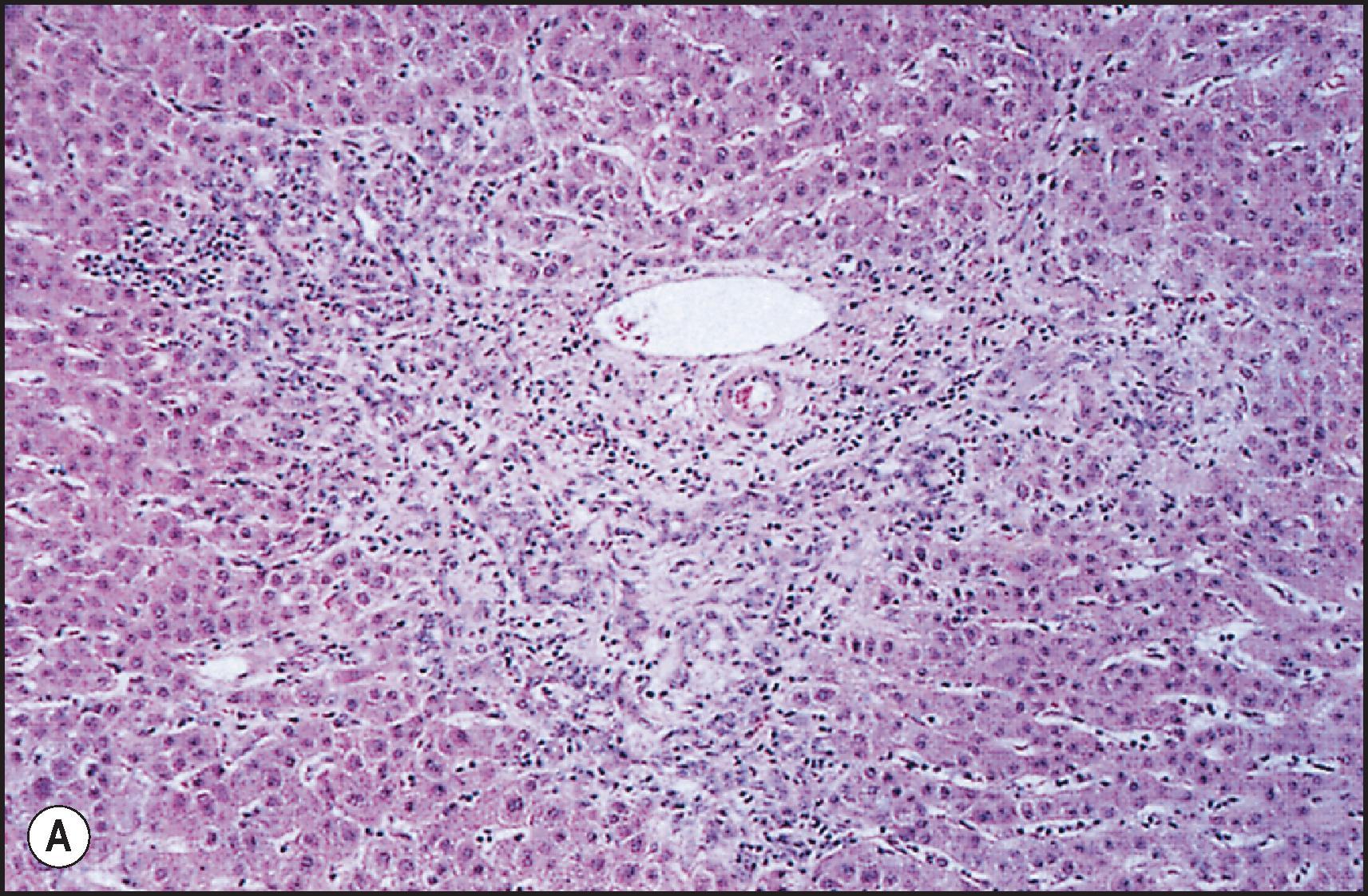
The term ‘cholate stasis’ is used to describe the cytological alterations that are thought to be caused by the intracellular detergent action of retained bile acids (see Chapter 1 ). Periportal hepatocytes are preferentially affected because they are the site of maximal bile acid transport in the normal liver. The hepatocytes are swollen and rounded with a distinct border and a clear cytoplasm that may contain web-like membranous and perinuclear granular remnants ( Fig. 9.21A ). They often contain copper and its binding protein, a polymerized form of metallothionein, which accumulates in lysosomes, where it is readily demonstrated as black/brown granules by orcein stain (see Chapter 2 ). This indirect method is a useful diagnostic tool since, at an early stage, in the absence of bilirubinostasis, the demonstration of copper or orcein-positive granules in the periportal regions is a good indicator of a chronic biliary process ( Fig. 9.21B ). , As the lesion progresses, the thread-like reticular cytoplasm, feathery degeneration , acquires a greenish brown tinge from impregnation with bilirubin, and bile pigment may later accumulate ( Fig. 9.21C ). During the process there is cytoskeletal injury, which often results in the formation of Mallory–Denk bodies ( Fig. 9.21D ). This is thought to result from a toxic effect of bile acids, and possibly copper, on the microtubules with consequent aggregation of intermediate microfilament proteins. Mallory–Denk bodies in chronic cholestasis are identical morphologically and chemically to those observed in alcoholic liver disease, but differ in having a periportal rather than a centrilobular location.
Bile ductules have the property of increasing in number in many forms of liver disease, especially in cholestasis. The ductules are accompanied by an inflammatory infiltrate and by fibrosis, the composite picture referred to as ‘ductular reaction’ ( Fig. 9.22B, C ). Their origin is still a matter of debate. The neoductules, lined by cuboidal or flattened cells, seem to arise from ‘ductular metaplasia’ of periportal hepatocytes in longstanding cholestasis, , and to a lesser extent from a proliferation of pre-existing ductules, although the relative role of these two mechanisms may vary depending on degree of biliary obstruction or duration of cholestasis. , A shift from the hepatocellular to the biliary cell phenotype can be demonstrated for keratins ( Fig. 9.22D ), blood group antigens, chromogranin and ‘bile duct-type’ integrins VLA 2, 3 and 6. The mechanism inducing ductular metaplasia of periportal hepatocytes appears to be complex, involving pericellular matrix components, possibly bile salts, hepatic stellate cells and various humoral and neural factors. A contribution of bone marrow-derived progenitor or stem cells to the ductular reaction remains speculative in the human liver.
Reactive ductular cells contain dense-core neuroendocrine-type granules and express chromogranin, neural cell adhesion molecule (NCAM or CD56) and parathyroid hormone-like peptide, a factor which modulates cellular growth and differentiation. These findings led to speculation that reactive ductular cells may produce a substance that exerts an autocrine or paracrine regulatory role on the growth of ductules or in the ductular metaplasia of periportal hepatocytes. , In the setting of primary cholangiopathies, reactive ductules coexpress NCAM and Bcl-2, suggesting a histogenesis that recapitulates the early stages of biliary ontogenesis.
The role of the ductular reaction is incompletely understood. The ductules may provide abortive bypass mechanisms for the drainage of bile in diseases associated with the destruction of interlobular bile ducts, such as PBC. The ductular cells reabsorb bile acids and may thus protect the hepatocytes from the deleterious effect of bile acid overload. Reabsorption with leakage of bile components leads to a marked inflammatory reaction, which consists mainly of polymorphonuclear leukocytes closely associated with the reactive ductules in the oedematous fibrous matrix at the portal periphery ( Fig. 9.22C ). These morphological features of acute cholangiolitis represent a tissue reaction to irritant chemical stimuli rather than indicating a bacterial infection.
Ductular reaction and the accompanying inflammatory reaction play an important role in portal and periportal fibrosis. The ductules produce and secrete a variety of biologically active materials such as cytokines and chemokines, including TNF-α, IL-6, IL-8, MCP1 and nitric oxide (NO), underpinning their potential role in the inflammatory reaction and concomitant fibrogenesis. Surrounded by a periodic acid-Schiff (PAS)-positive basement membrane, the neoductules are invariably set in a loose connective tissue matrix deposition which contains type IV collagen and laminin, in part synthesized by the ductular cells themselves. Fibrosis also results from stimulation of mesenchymal cells. Reactive ductules express growth factors, such as connective tissue growth factor (CTGF), TGF-β2 and platelet-derived growth factor (PDGF), which activate mesenchymal cells and matrix production. , Intimately associated with the ductules are myofibroblasts and transitional cells between hepatic stellate cells and myofibroblasts expressing smooth muscle actin and desmin. , They are responsible for the production of tenascin in the early stage of ductular reaction, followed later on by deposition of type VI collagen, matrix components and interstitial collagen types I, III and V.
In this way, the ductular reaction is a pacemaker for the development of progressive fibrosis in chronic cholestatic liver disease, eventually resulting in biliary cirrhosis and the associated haemodynamic alterations. In the two chronic cholestatic disorders, paucity of the intrahepatic bile ducts (Alagille syndrome) and chronic liver allograft rejection, in which ductular reaction is typically absent, periportal fibrosis is similarly inconspicuous. The ductular reaction and periductular fibrosis are reversible in the early stage. After removal of the proliferative stimulus (e.g. after relief of bile duct obstruction), the excess ductular cells are deleted by apoptosis. Regression of the ductular reaction is accompanied by regression of the periductular fibrosis.
Periportal hepatocytes facing the portal connective tissue show ductular features with coexpression of biliary markers such keratin 7 (K7) or 19 (K19) while still bearing hepatocellular phenotypes, such as deposition of copper and copper-associated protein. Small-cell changes of periportal and occasionally midzonal hepatocytes are a reflection of chronic biliary disease, and such changes could suggest diagnosis of PBC. Expression by periportal hepatocytes of biliary K7 and K19 is also an early marker of chronic cholestasis, with K7 usually becoming positive earlier than K19. A recent study suggested that K7 expression in periportal hepatocytes is a more sensitive marker of early chronic cholestasis than the deposition of copper or copper-associated protein.
In chronic large-duct obstruction and intrahepatic bile duct loss, biliary interface activity and fibrosis steadily progress. The limiting plates become irregular with separation of hepatocytes by deposition of loose fibrous tissue, which contrasts sharply with the compact collagen of the original portal tract or later of the central core of the fibrous septa ( Fig. 9.23A ). Hepatocytes manifesting cholate stasis become intermingled with smaller hepatocytes having a darker-staining cytoplasm that acquire phenotypic characteristics of duct cells, in particular the expression of K7 and K19; these merge imperceptibly with the reactive neoductules. The associated inflammatory infiltrate is usually less dense and of different cellular composition than that observed at the interface in AIH (see Chapter 8 ). Neutrophils predominate, and there is variable accumulation of cholesterol/lipid-laden macrophages with a foamy or microvesicular appearance—xanthomatous cells (see Fig. 9.21C ). These may be difficult to distinguish from hepatocytes showing cholate stasis on H&E-stained sections.
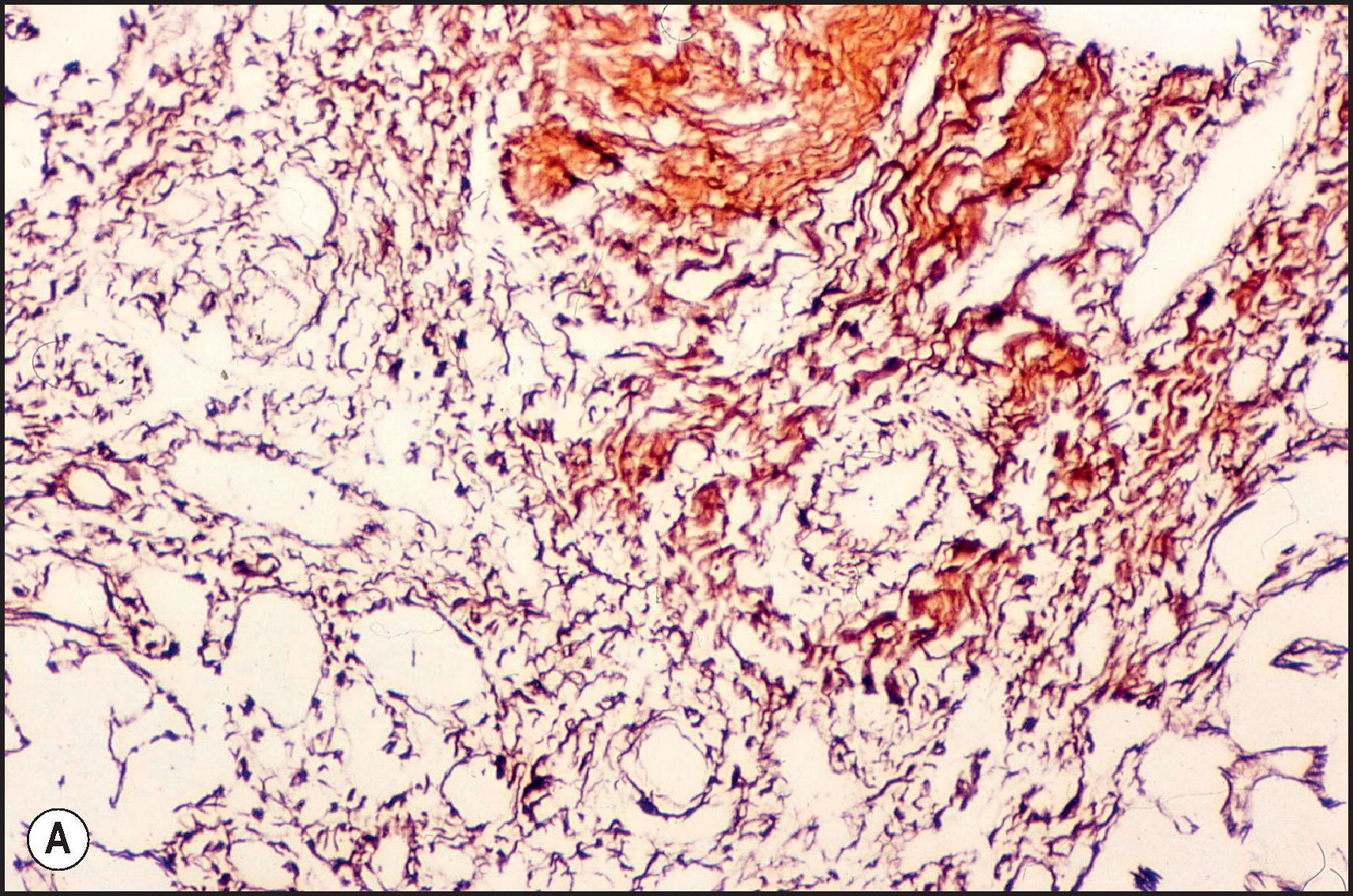
Progressive fibrosis in the periportal zone produces gradual enlargement of the portal tracts, followed by the formation of fibrous septa bridging adjacent portal tracts, and eventually the development of a micronodular cirrhosis with parenchymal regeneration and distortion ( Fig. 9.23B ). Until well advanced, the basic architecture is preserved, with hepatic venules and portal tracts maintaining an almost normal anatomical relationship, giving rise to the term monolobular cirrhosis . This provides a hint as to the biliary aetiology of the lesion but may lead to difficulty in deciding morphologically when a true cirrhosis has been established ( Fig. 9.23B ). The features of cholate stasis and the deposition of oedematous collagen matrix produce a striking ‘halo’ at the interface between hepatocytes and septa, further indicating the biliary nature of the lesion ( Fig. 9.23B–D ).
Much of the cellular and tissue damage is caused by retention of hydrophobic, cytotoxic bile acids. UDCA appears to protect rat hepatocytes in vitro and in vivo against such cytotoxic damage. UDCA inhibits, at least in part, the biological and toxic effects of the endogenous bile acids by reducing their concentration within and around the liver cells, while UDCA itself is devoid of toxicity. This explains the wide use of this drug in the treatment of chronic cholestatic disorders in both adults and children.
PBC is an autoimmune liver disease of unknown aetiology that selectively affects the small intrahepatic bile ducts ( Fig. 9.24 ). Along with the progressive bile duct damage and chronic cholestasis, biliary fibrosis/cirrhosis then develops, leading eventually to hepatic failure. The term ‘primary biliary cirrhosis’ was established by Ahrens et al. in 1950 and was widely used for more than six decades. However, the term is inaccurate for many patients in whom a true cirrhosis only develops in the later stages of the disease, or sometimes not at all. Because of these limitations, an alternative term ‘primary biliary cholangitis’ was proposed in 2015 by an international panel of experts to describe this condition. The move in terminology from ‘cirrhosis’ to ‘cholangitis’ was intended to remove the misconceptions and possible stigmata associated with having a diagnosis of cirrhosis while still allowing continued use of the acronym ‘PBC’. Although there are also criticisms of the newly proposed terminology, notably the tautologous use of the words ‘biliary’ and ‘cholangitis’, it is now being used widely. ‘Chronic nonsuppurative destructive cholangitis’ (CNSDC) 209 accurately describes the morphological changes involving bile ducts in PBC, but this term has not been widely accepted for routine clinical practice.
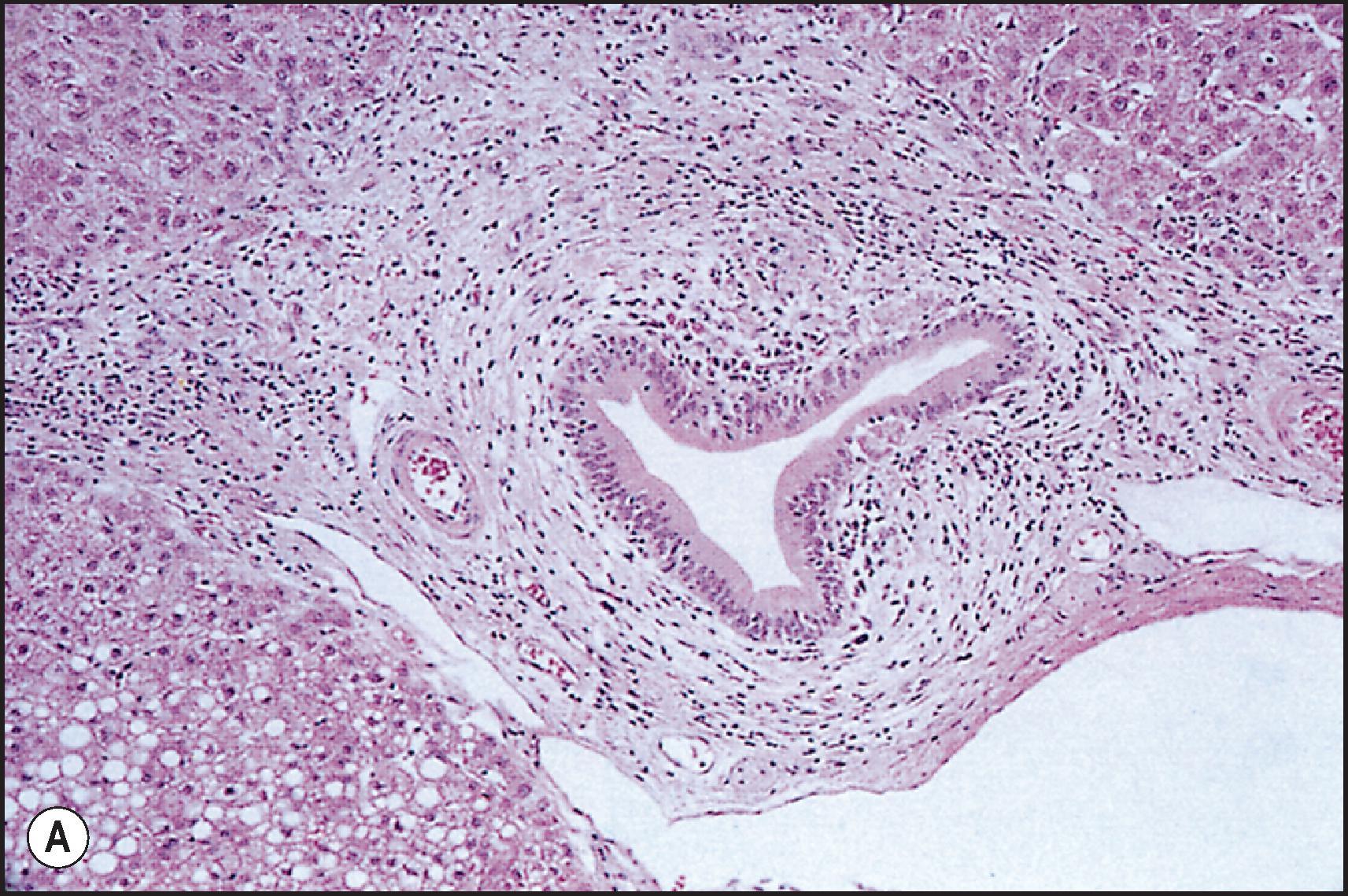
PBC usually affects middle-aged to elderly women, with a peak incidence in the 40–60 age group. Unlike PSC, it is rare before age 30. A female preponderance of 9–10:1 is well known; however, recent studies reported lower gender ratios (F/M = 2–6:1). , This could be related to the increased expression of oestrogen receptor found in biliary epithelial cells in PBC, because the expression of oestrogen receptor and relevant molecules in cholangiocytes increases susceptibility to Bcl-2 family-mediated apoptosis. , The disease is generally similar in both genders, except that males were found to have less pruritus and skin pigmentation and a higher incidence of hepatocellular carcinoma (HCC).
Although PBC occurs worldwide and has been found in all races, there is some geographical variation in incidence, with few cases reported from the India and the African continent. The prevalence and annual incidence per million population are 283–456 and 9.0–30.3 in Europe and North America and 118 and 8.6 in Asia-Pacific, respectively. , An increased awareness of the condition and the diagnosis of asymptomatic patients seem to account for the apparent rise in the incidence and prevalence of PBC.
Another recent cohort study reported that the prevalence of isolated AMA without evidence of PBC is 16.1 per 100,000 population, and the development of PBC was confirmed in 10% of them in a median follow-up period of 4 years. Cumulative incidence rates of PBC in subjects without ALP elevation, pruritus or liver cirrhosis at baseline were 2% in 1 year, 7% in 3 years and 16% in 5 years. The low incidence of PBC development in AMA-positive population has questioned the dogma that AMA plays a central role in the development of PBC.
The incidental finding of hepatomegaly, increased serum ALP or serum AMA may lead to a diagnosis of asymptomatic PBC. Some patients remain asymptomatic for years and experience a normal life expectancy, although an increased mortality is shown for those in whom symptoms subsequently develop. , Insidious in onset, the presenting features are usually pruritus and lethargy with increasing skin pigmentation and eventually cholestatic jaundice, although icterus may not develop for years after the initial symptoms. Some patients first present with jaundice, particularly during pregnancy or after drug intake, and hepatic decompensation occasionally may bring the patient to clinical notice. Portal hypertension may become manifest before a true cirrhosis is established. Xanthomas/xanthelasmas occur in 30% of patients. ,
PBC eventually progresses in most cases. Its natural history is thought to be about 20 years, and the onset of jaundice, usually in the last 5–7 years, heralds clinical deterioration. Death is usually caused by hepatocellular failure, with bleeding from oesophageal varices in approximately 30% of patients ; nonhepatic causes of death are found in <20%. Predicting the prognosis is a major issue, with the use of LT as the only treatment option in patients with advanced disease. Several models based on multiple regression analysis of clinical, biochemical and histopathological variables have been proposed, and serum bilirubin levels, presence of bridging fibrosis/cirrhosis and tissue deposition of abundant copper-associated proteins are the most significant risk factors. Ductopenia has also been shown to predict disease progression in PBC. Failure to obtain a biochemical response to treatment with UDCA has been recognized as a risk factor for disease progression and for the development of HCC. ,
The coexistence of PBC with other autoimmune diseases is found in about 55% of patients. Features of Sjögren syndrome or the ‘sicca complex’ of dry eyes and dry mouth may be found in more than half the patients. PBC may be associated with all or some of the features of the CREST syndrome—calcinosis, Raynaud phenomenon, oesophageal dysfunction, sclerodactyly and telangiectasis—to which the presence of anticentromere antibodies and keratoconjunctivitis sicca was later added. Other potential associations include rheumatoid arthritis, autoimmune thyroiditis, renal tubular acidosis, coeliac disease, systemic lupus erythematosus and vasculitis. In one pathological study of common variable immunodeficiency, the histological features of PBC were observed in 2/24 patients, both positive for AMA. Many other conditions have also been reported, but most of these rare associations are probably coincidental.
Liver enzymes show a normal or mildly elevated bilirubin level (34–68 µmol/L; 2–4 mg/dL) at early stages, accompanied by a striking and disproportionate elevation of serum ALP to levels three to five times normal, although a normal value does not preclude the diagnosis. Increased bilirubin raises a concern of advanced disease. There is a moderate elevation of serum aminotransferase (transaminase) levels (100–150 IU/L). Serum immunoglobulins of all three major classes may be increased, but greatly elevated IgM in excess of 150% of normal is most consistent and is a distinctive feature of PBC.
The most helpful diagnostic test is the demonstration of AMAs, which are found in the sera of more than 95% of patients. Following antigen cloning and better definition, the major autoantigens which AMAs recognize are now identified as components of the 2-oxo-acid dehydrogenase complex (2-OADC), an enzyme complex located on the mammalian inner mitochondrial membranes. AMAs in more than 95% of PBC patients are strongly reactive with epitopes in PDC-E2 components and also with components of other 2-OADCs. In about half of PBC patients, AMAs are known to react with BCOAD-E2 (E2 component of branched-chain 2-OADC, 52 kD) and in 40–88% of PBC patients with OGDC-E2 (E2 component of 2-oxoglutarate dehydrogenase complex, 48 kD). The occurrence of ANA of centromere type is also characteristic for PBC. In addition, autoantibodies against a 210-kD glycoprotein of the nuclear membrane (gp210) and Sp100 nucleoprotein are highly specific for PBC. Although these ANAs are detectable less often than AMAs, they are useful for the diagnosis in AMA-negative cases.
Become a Clinical Tree membership for Full access and enjoy Unlimited articles
If you are a member. Log in here